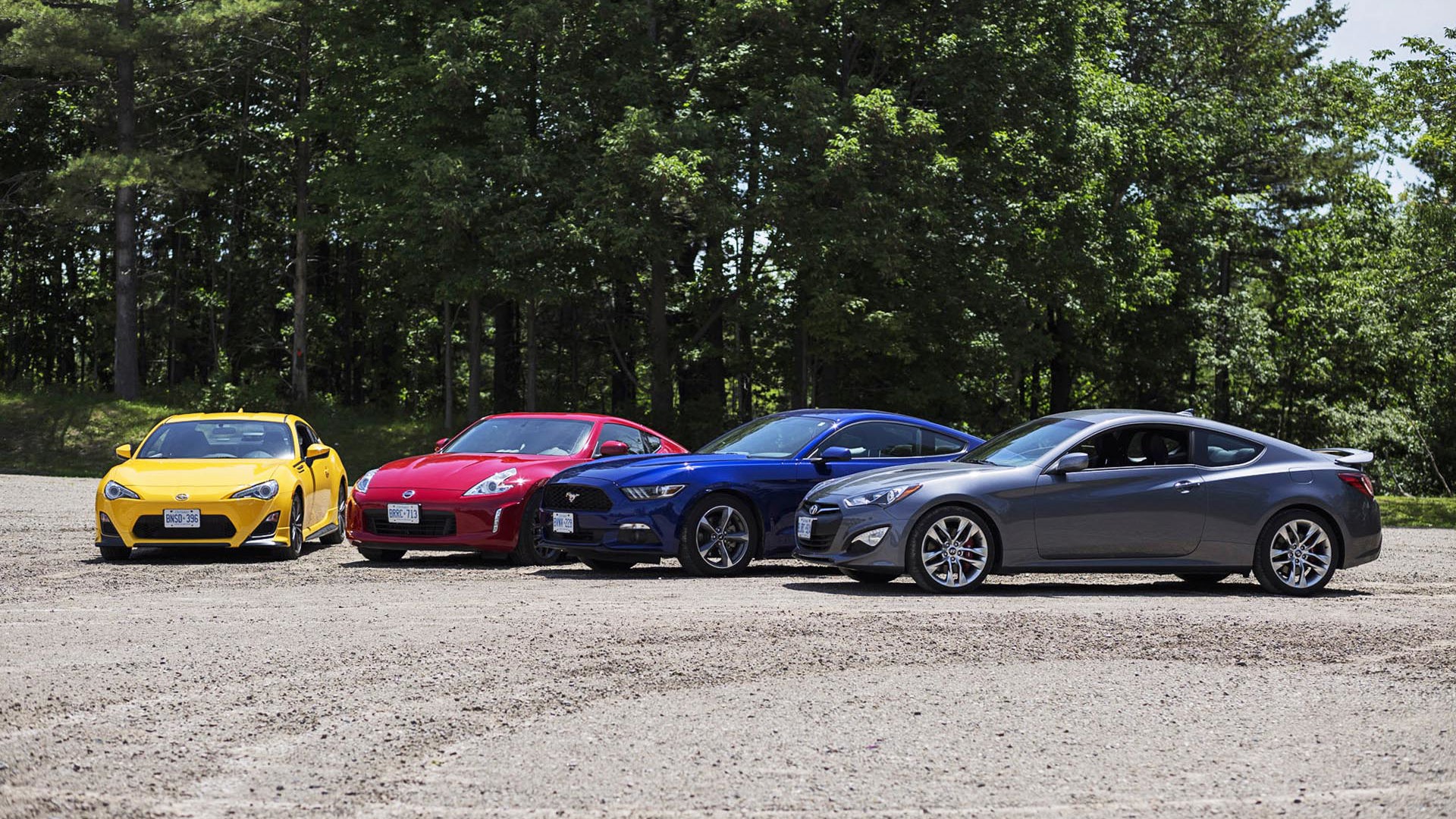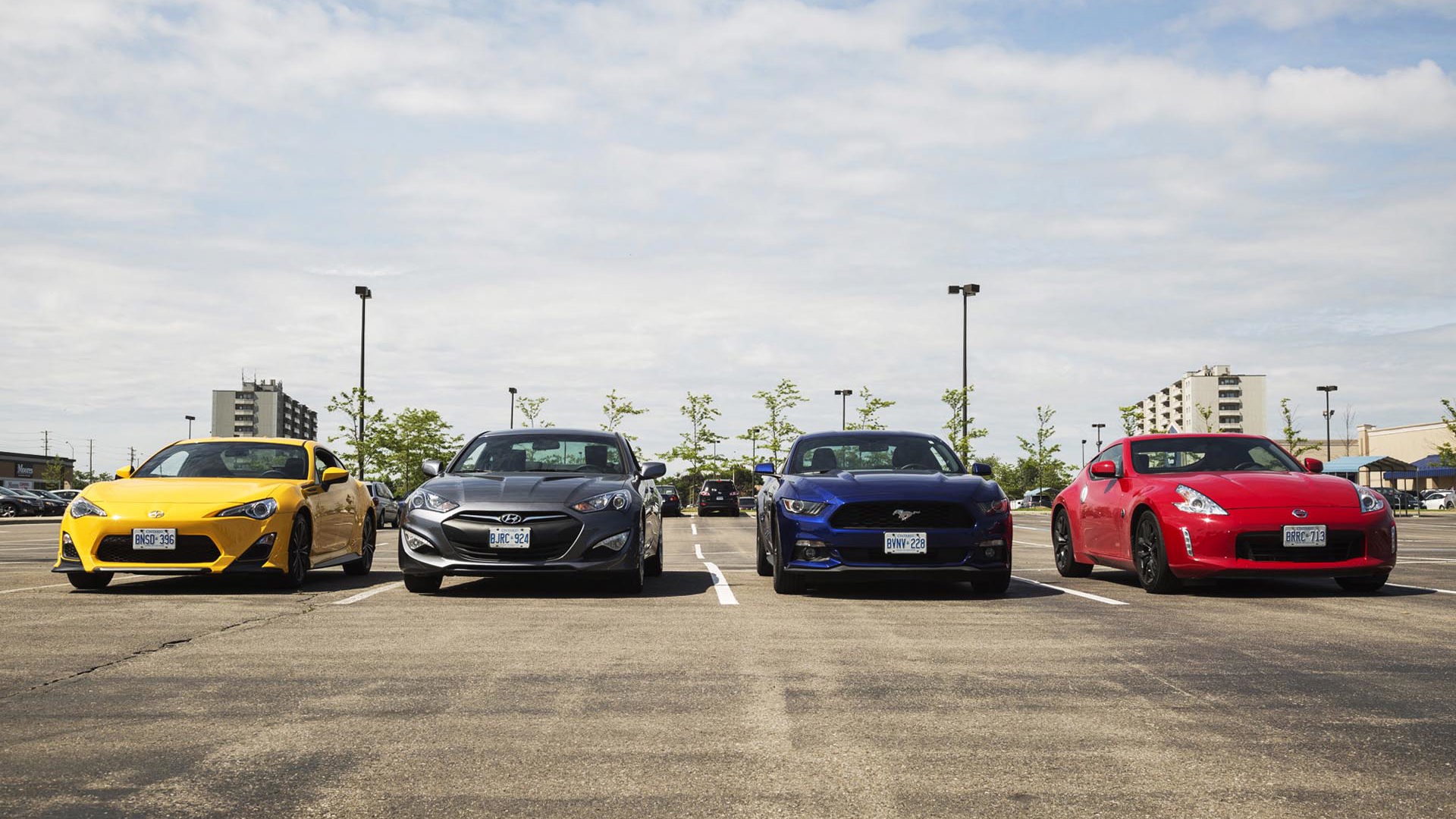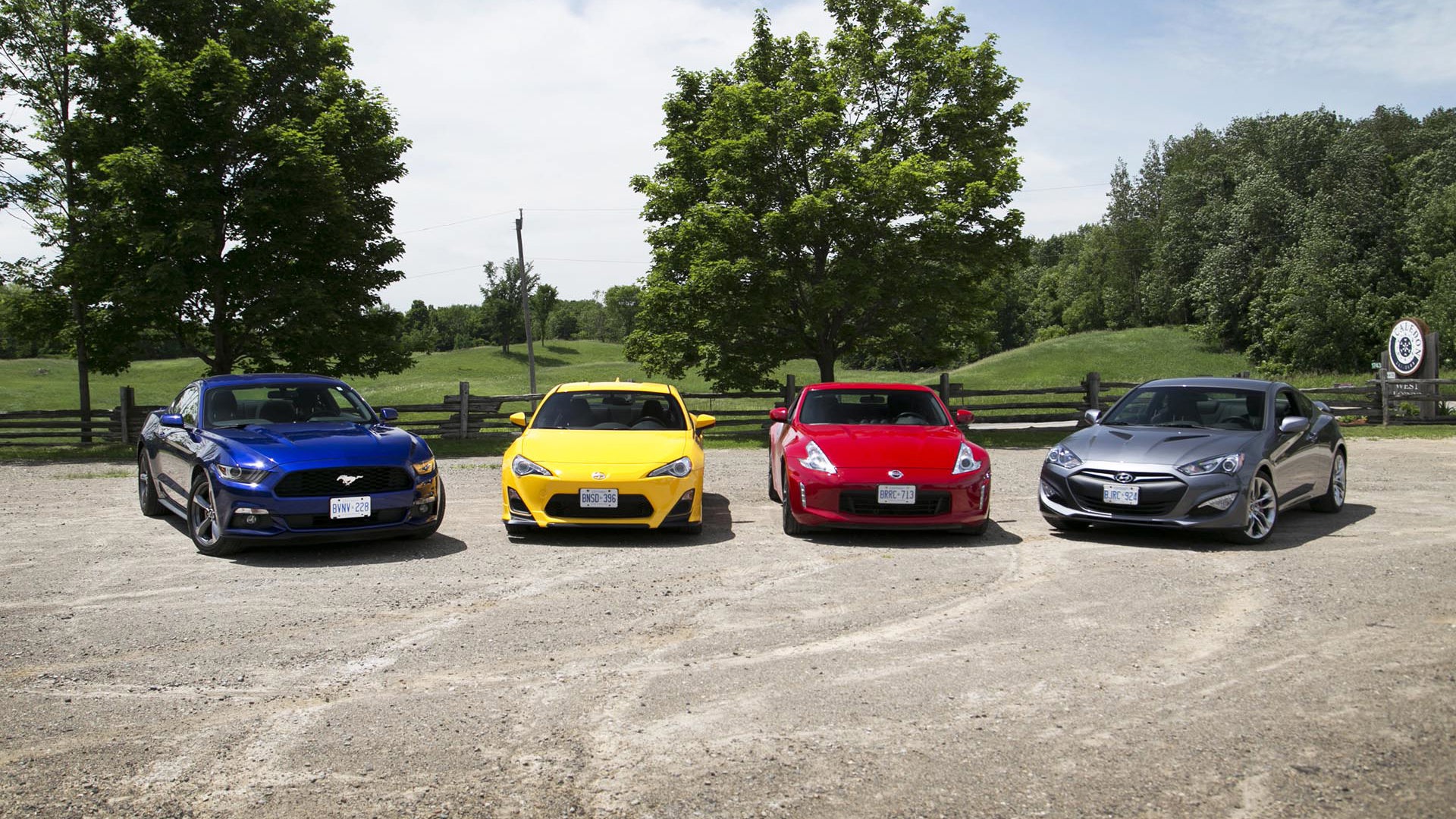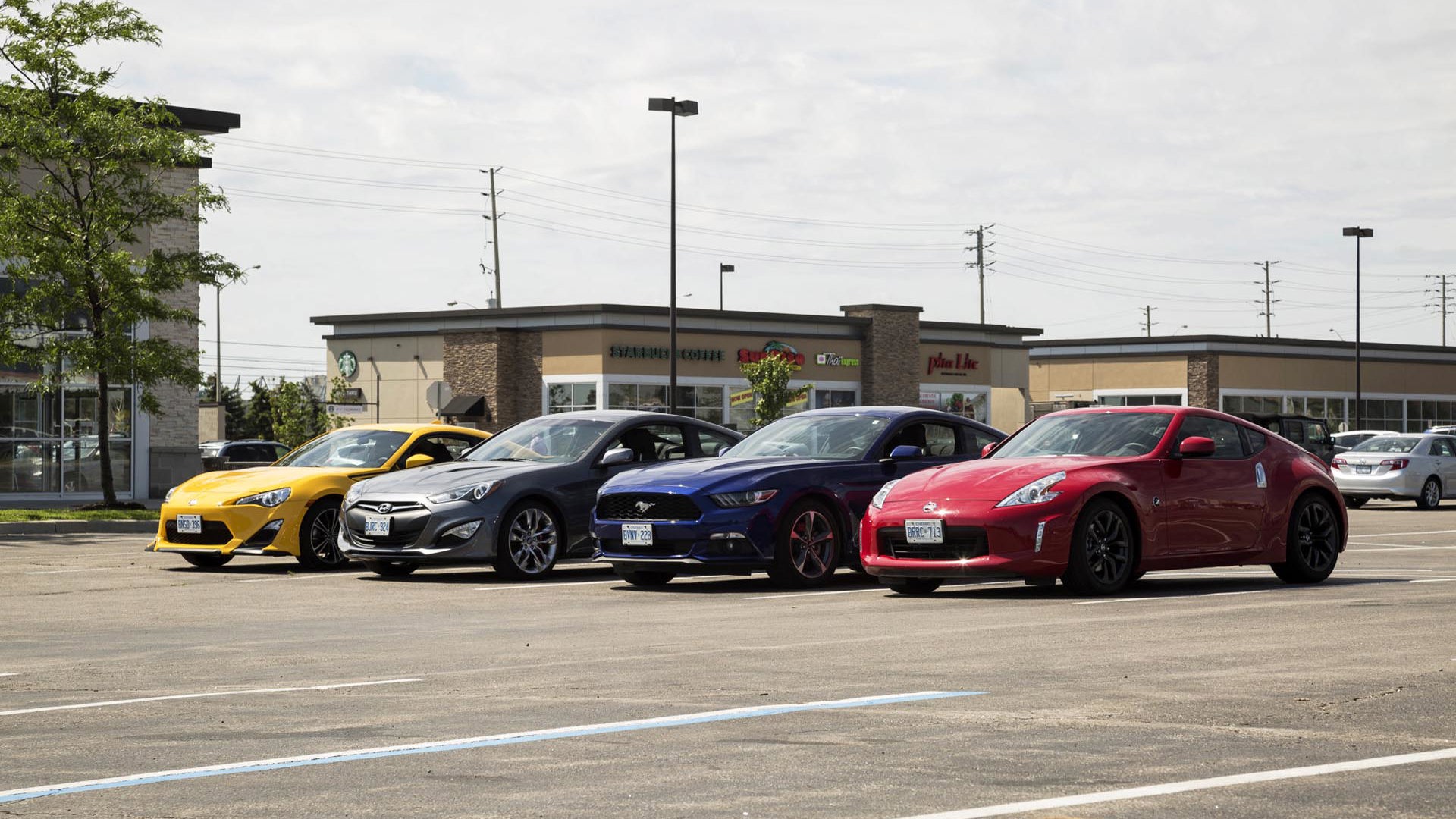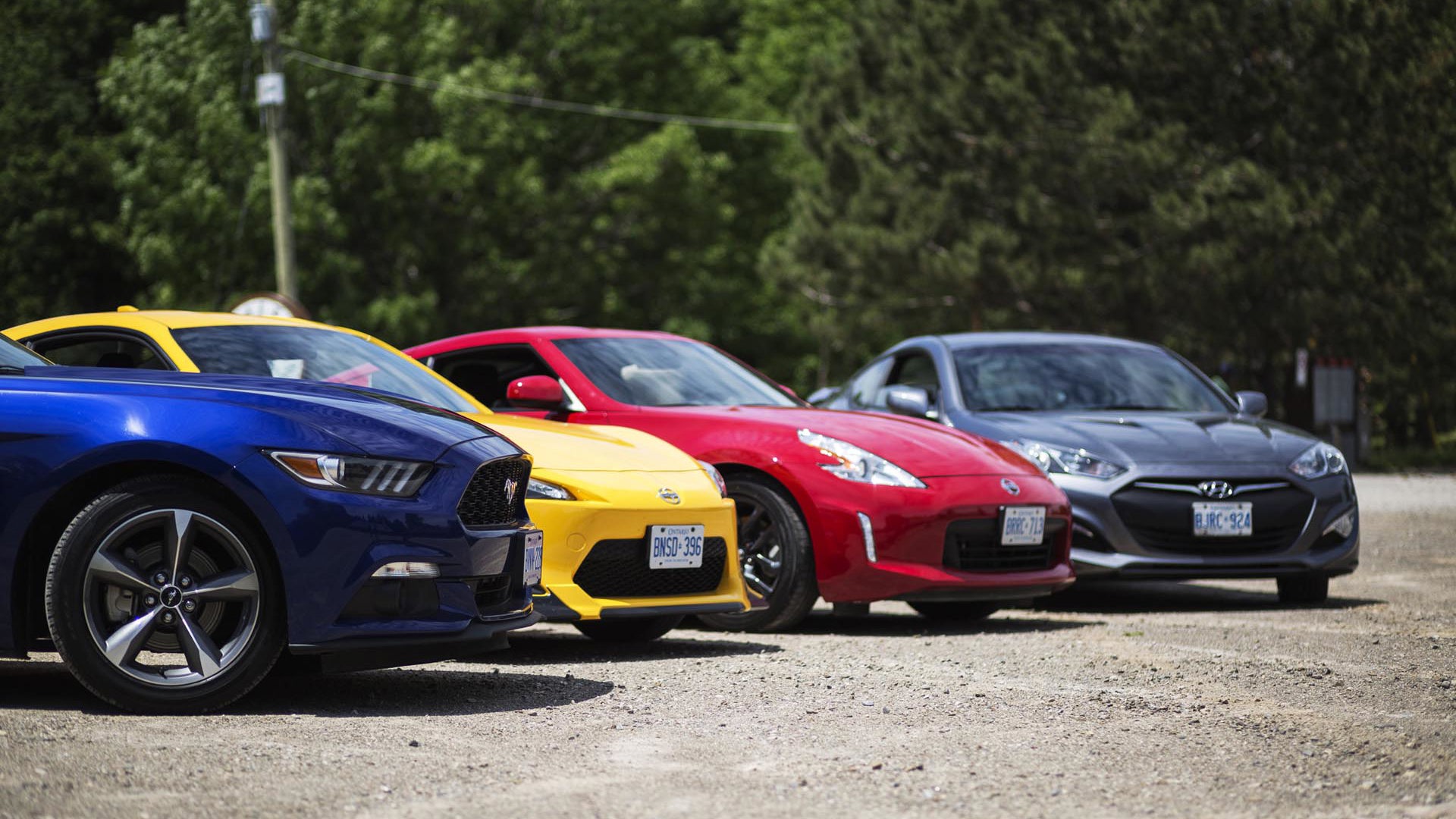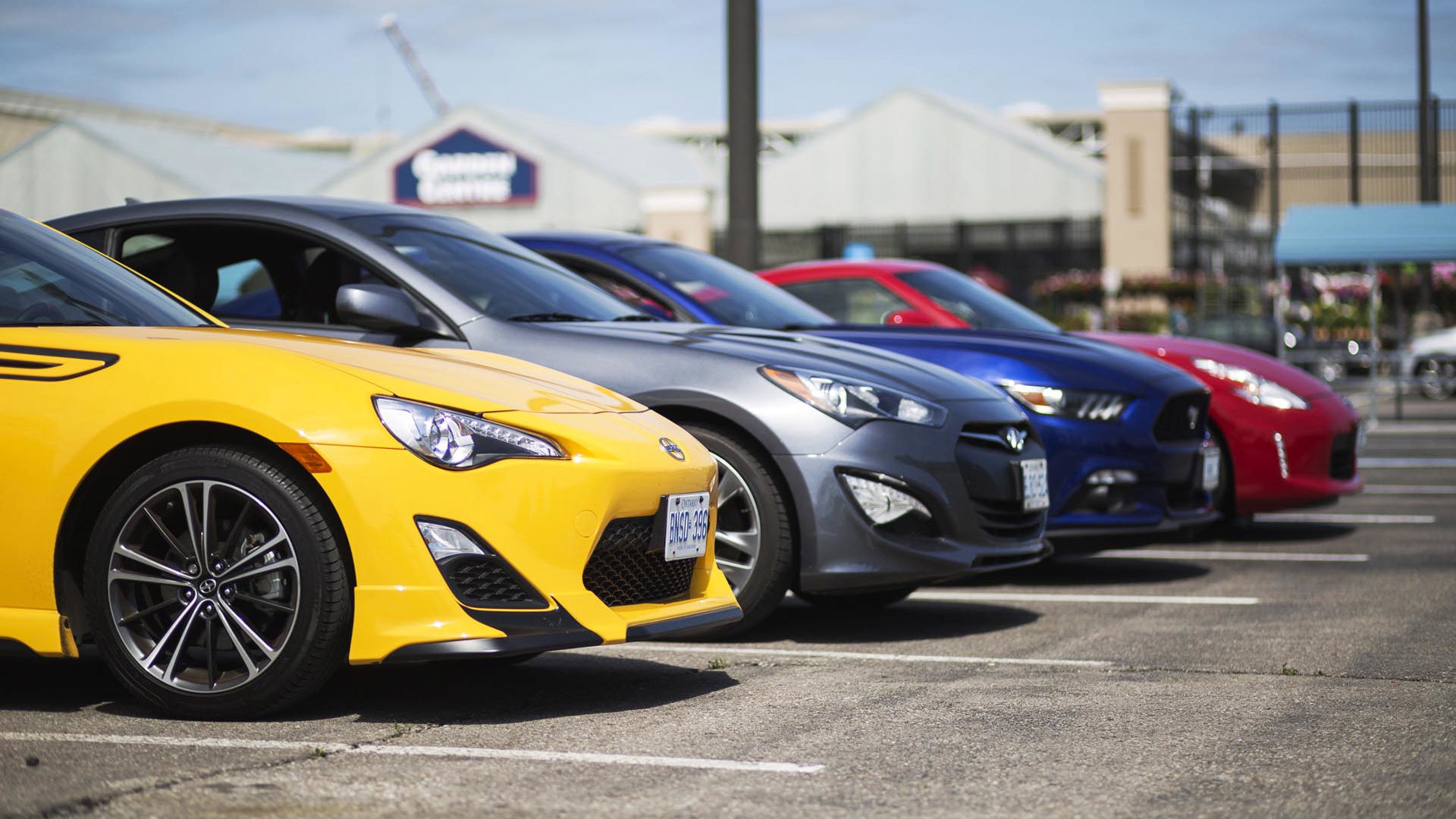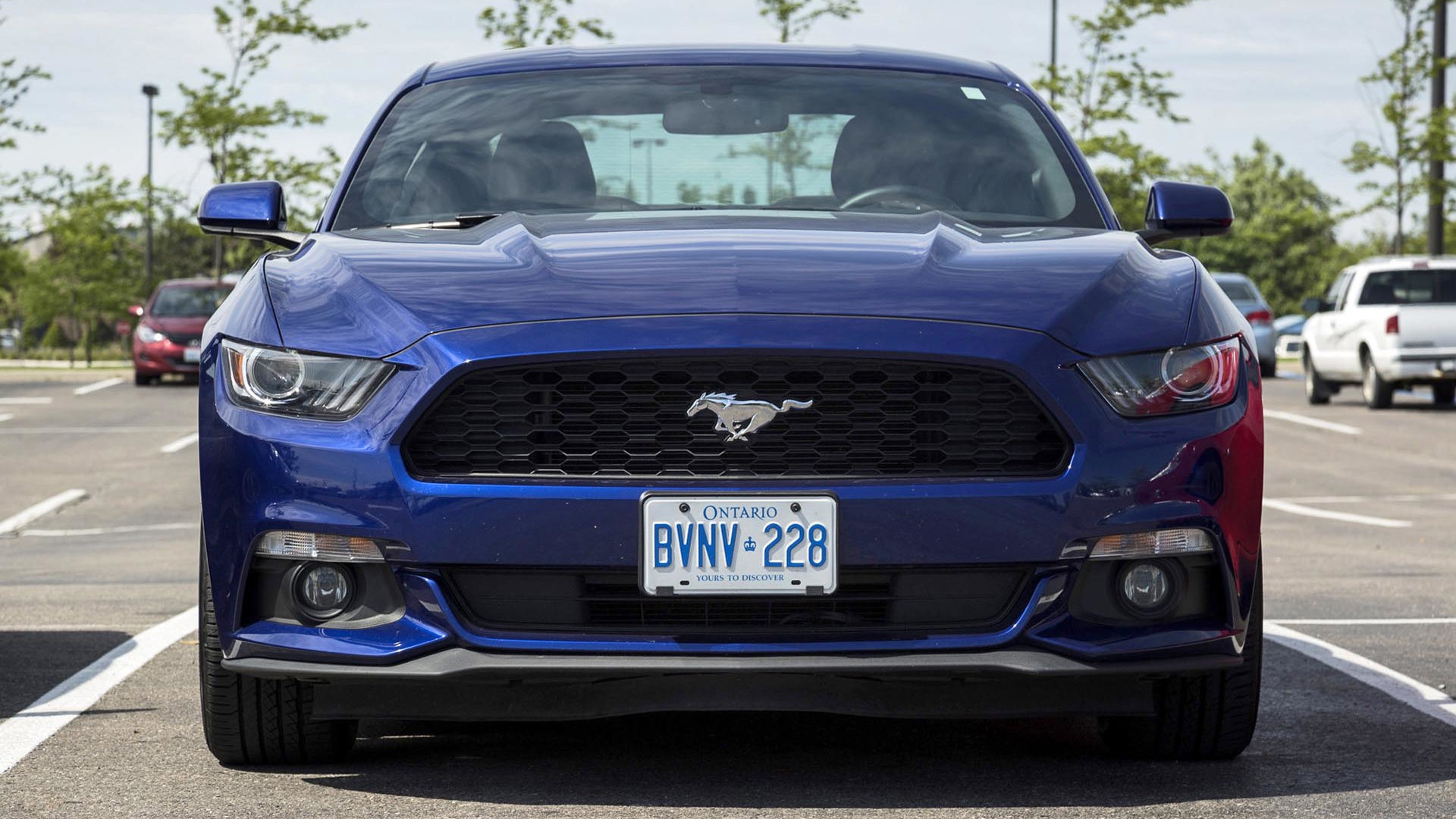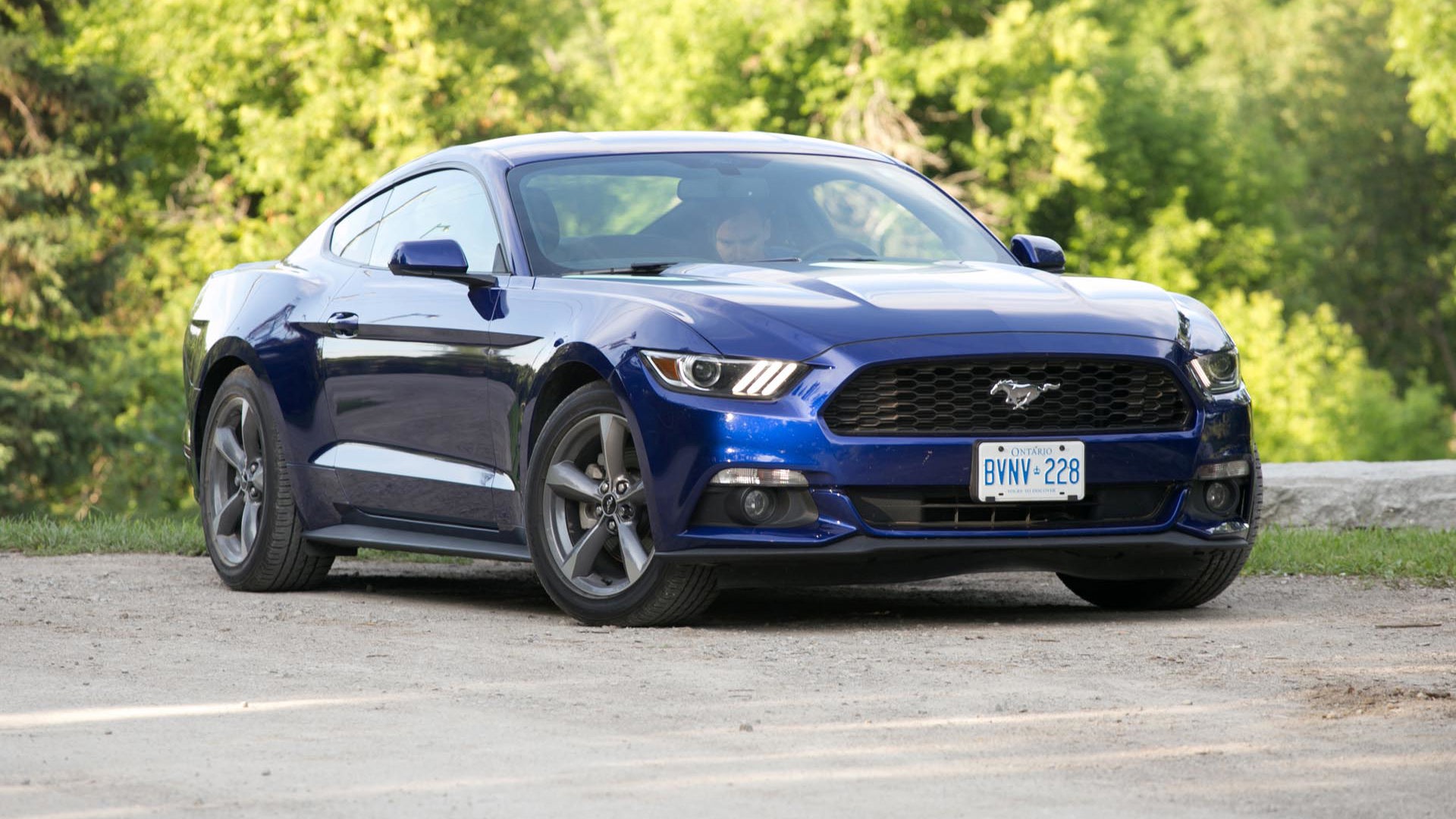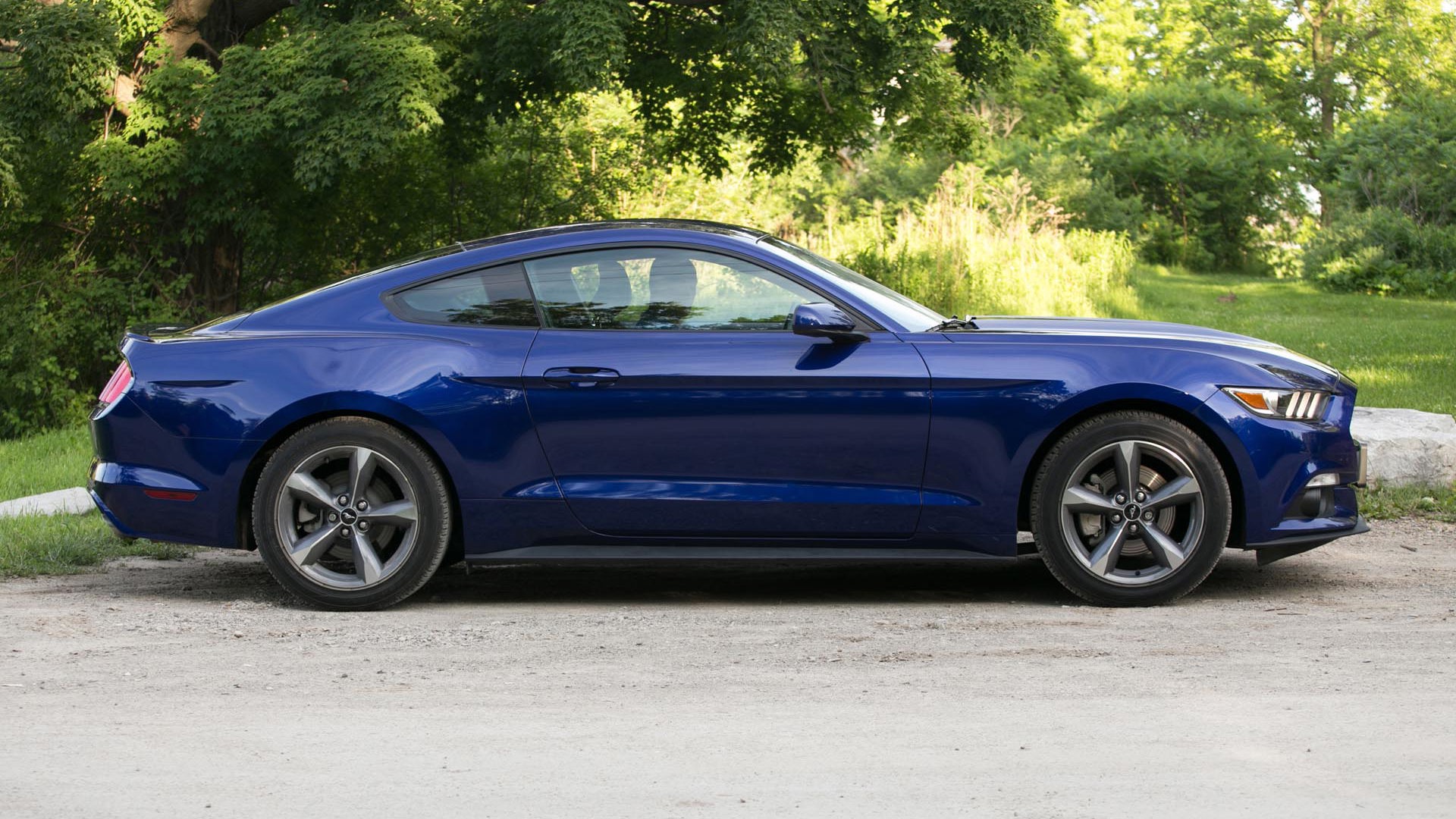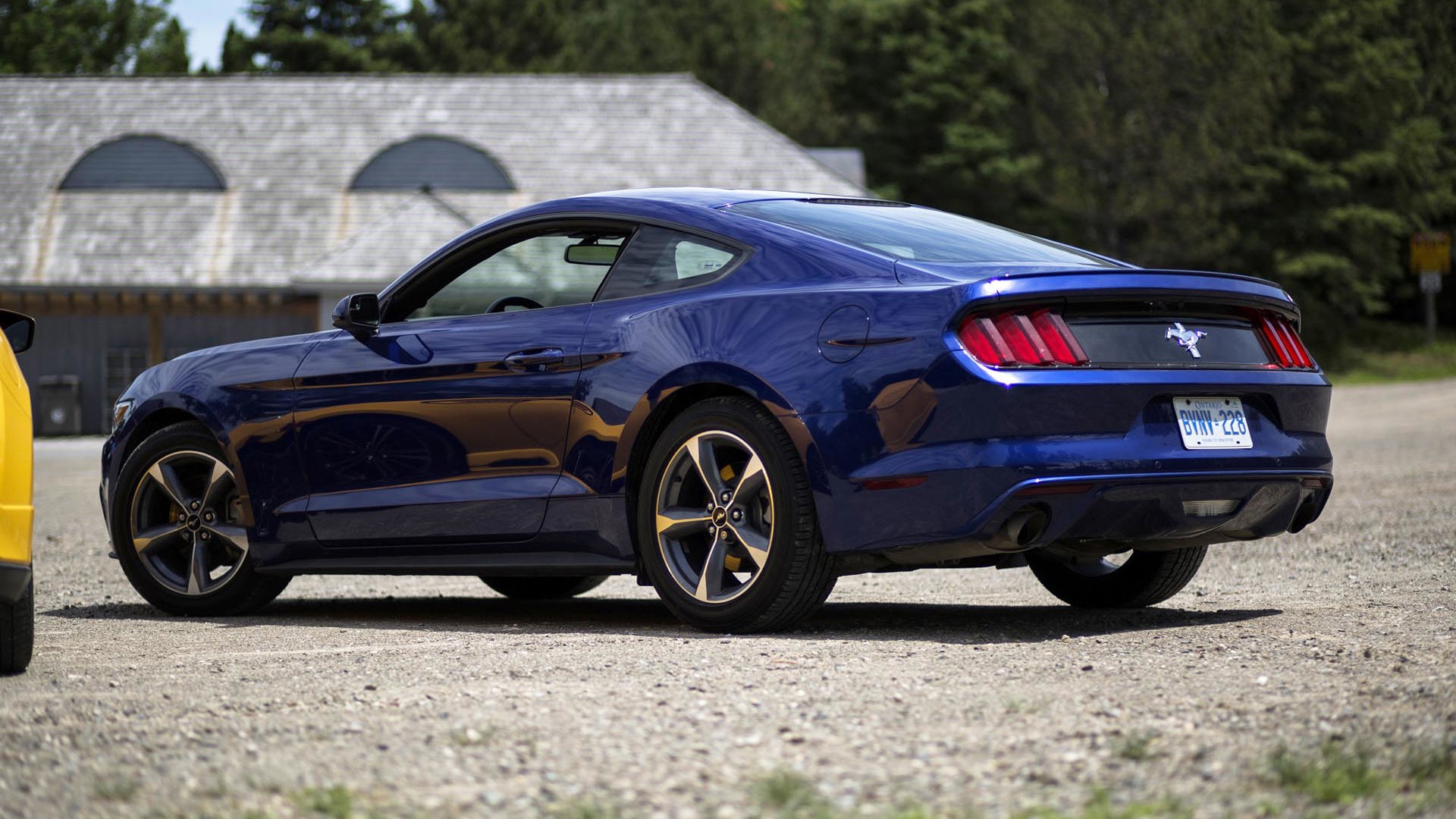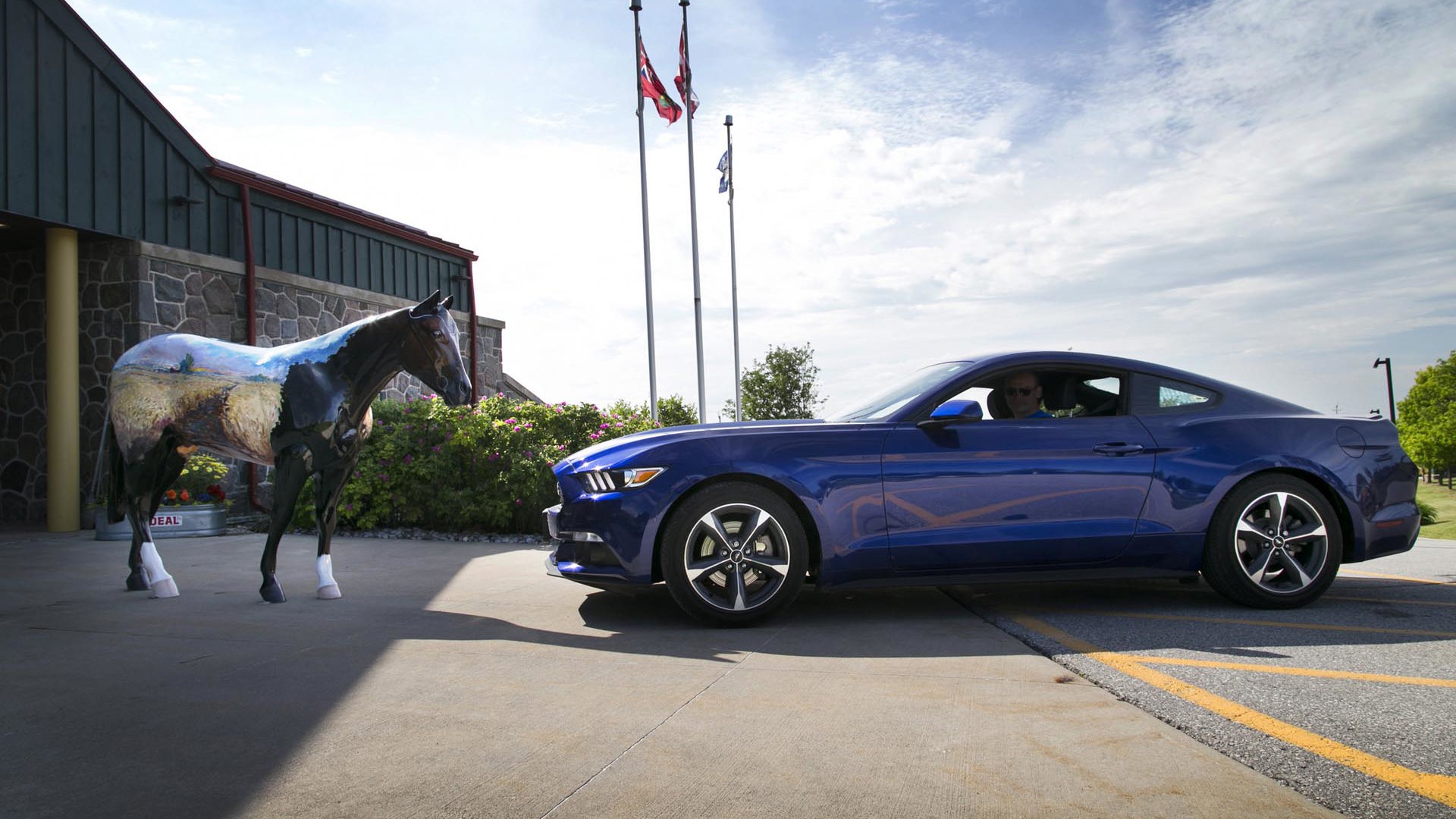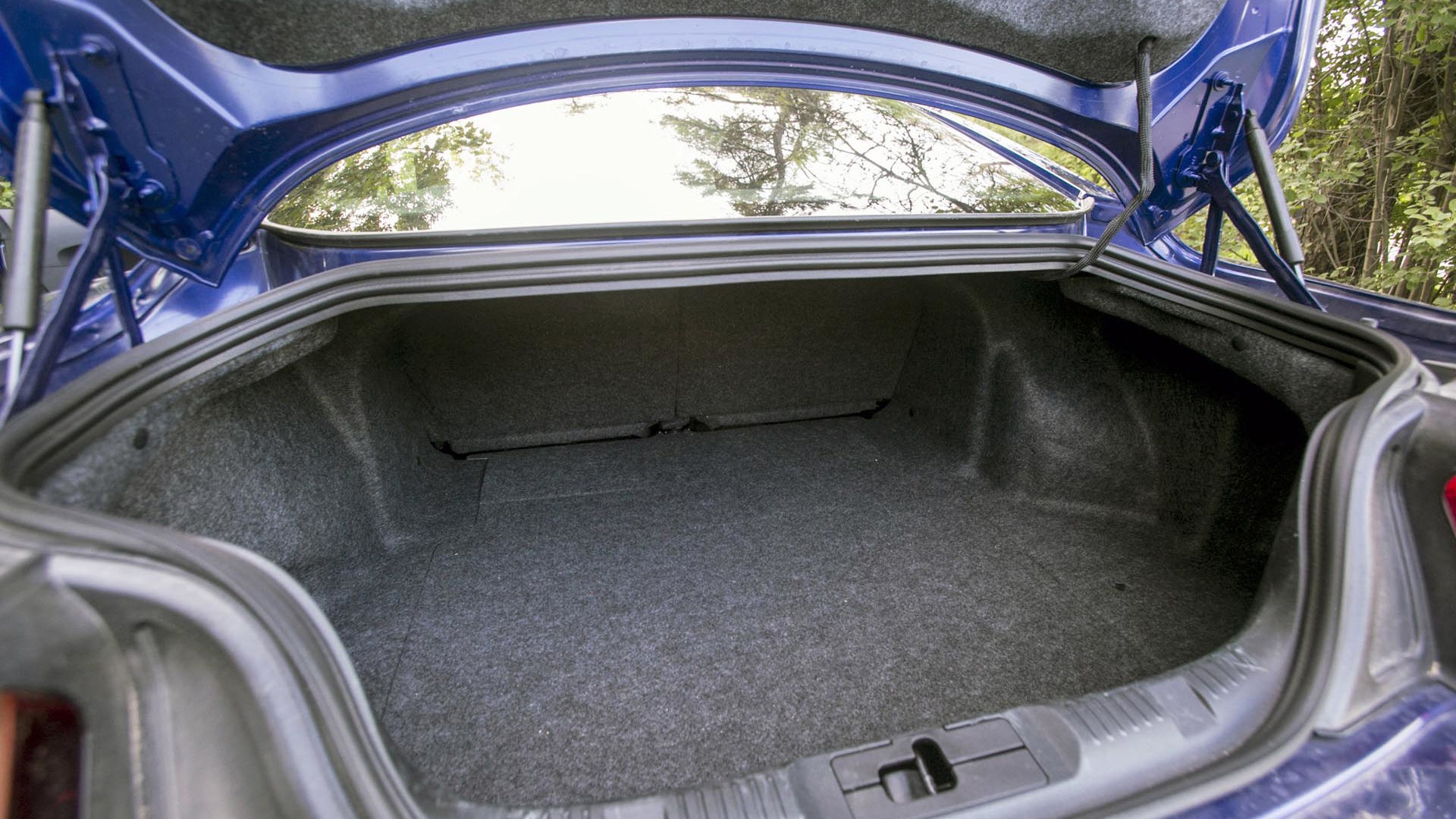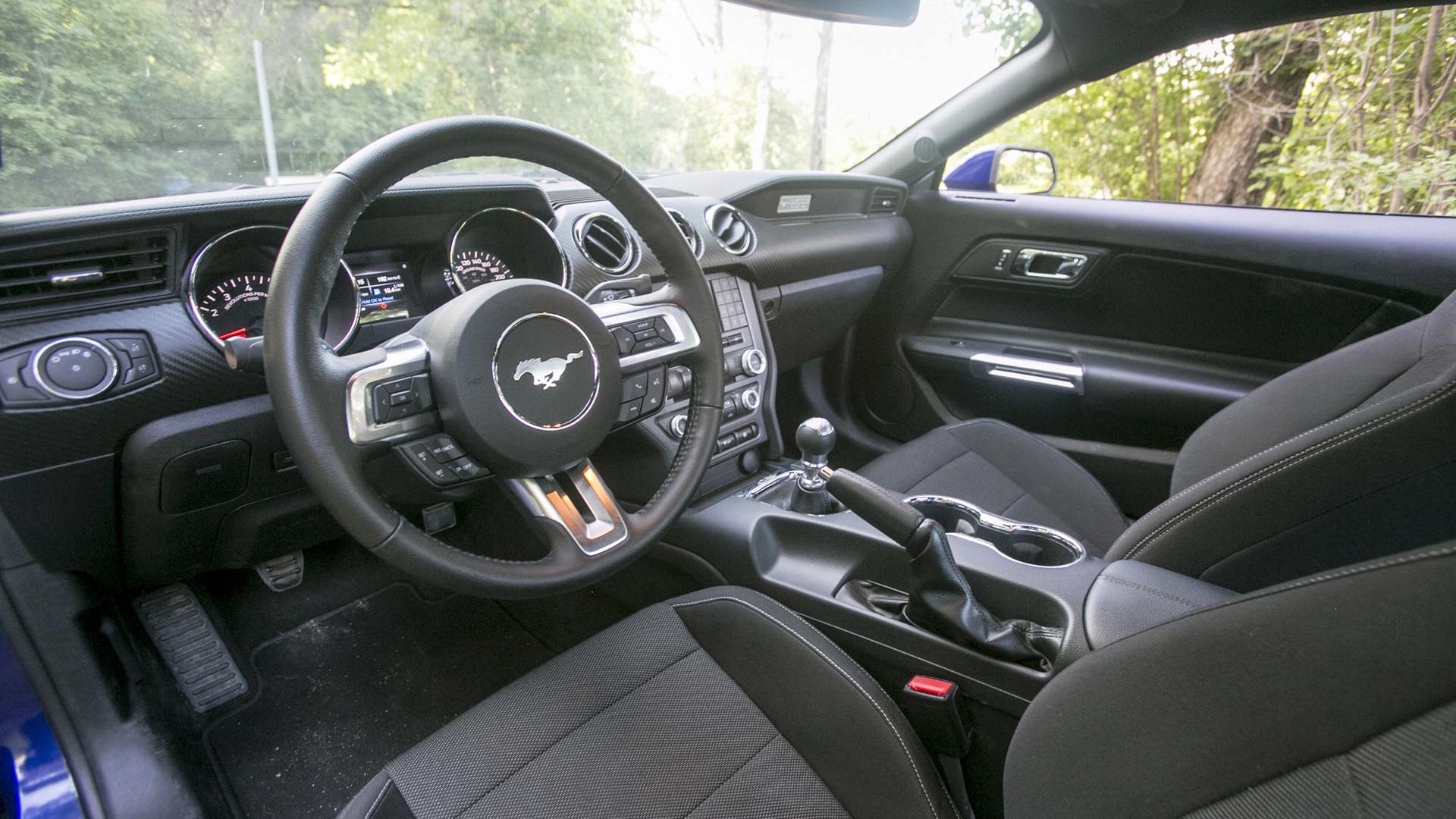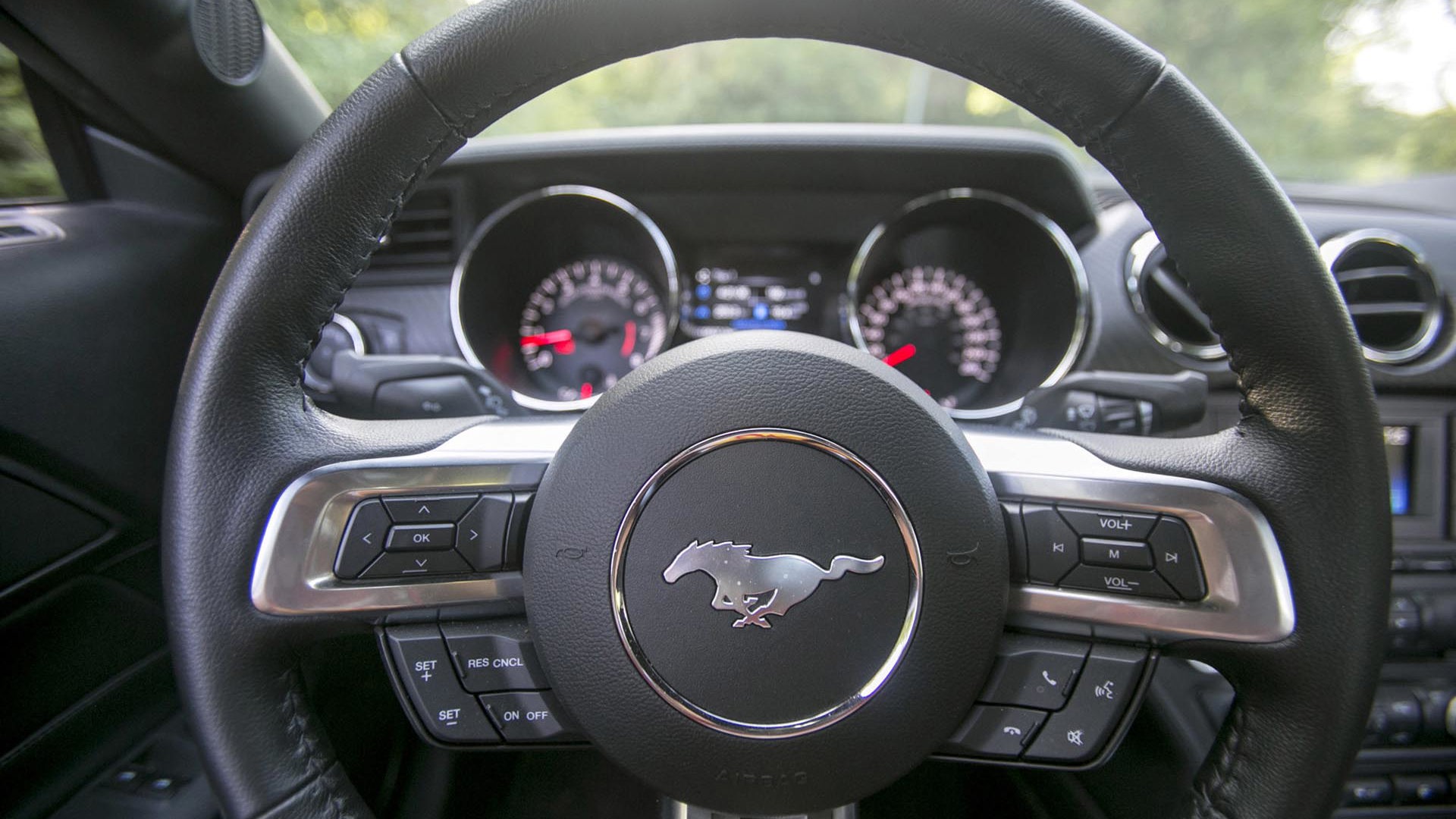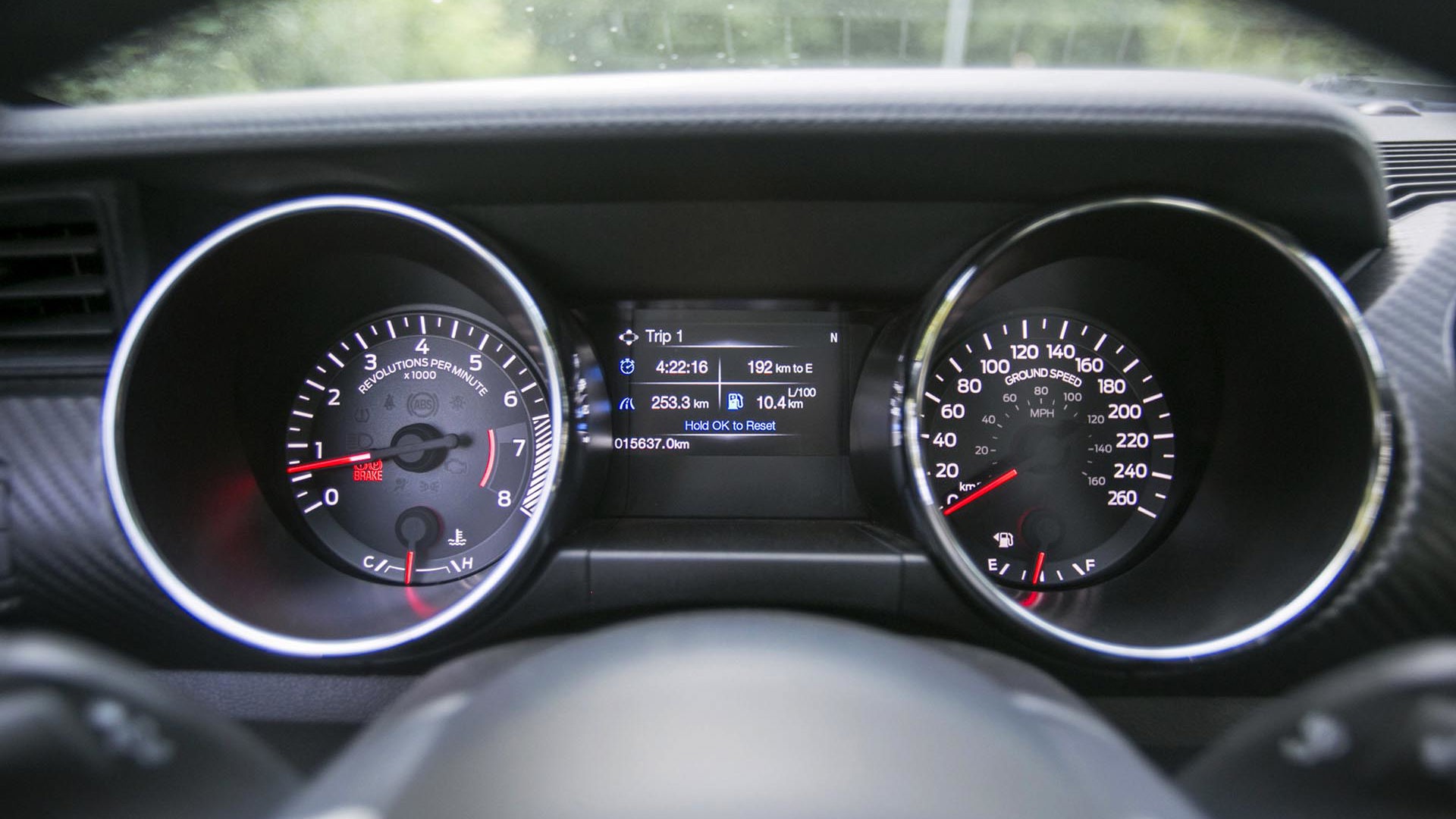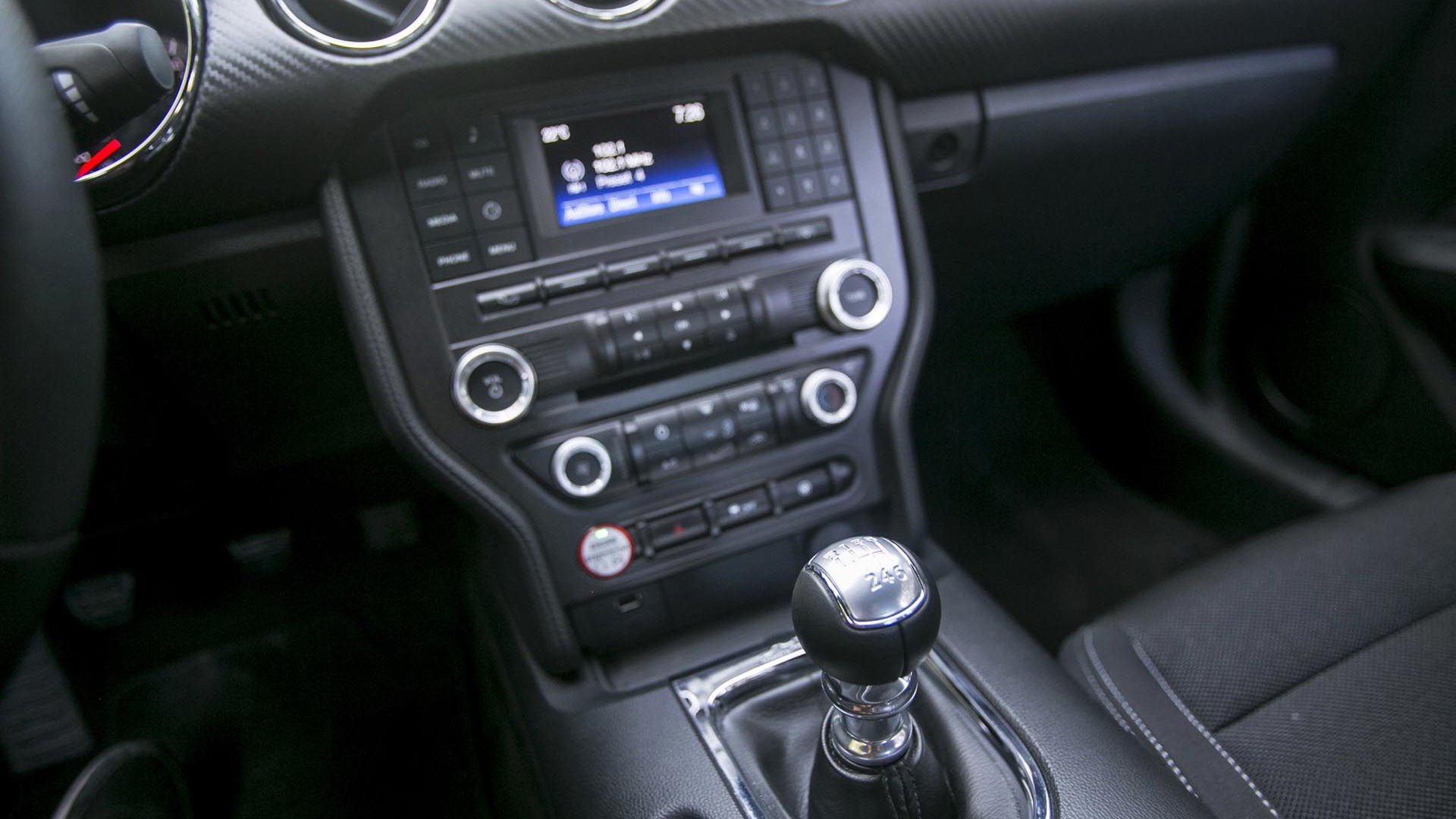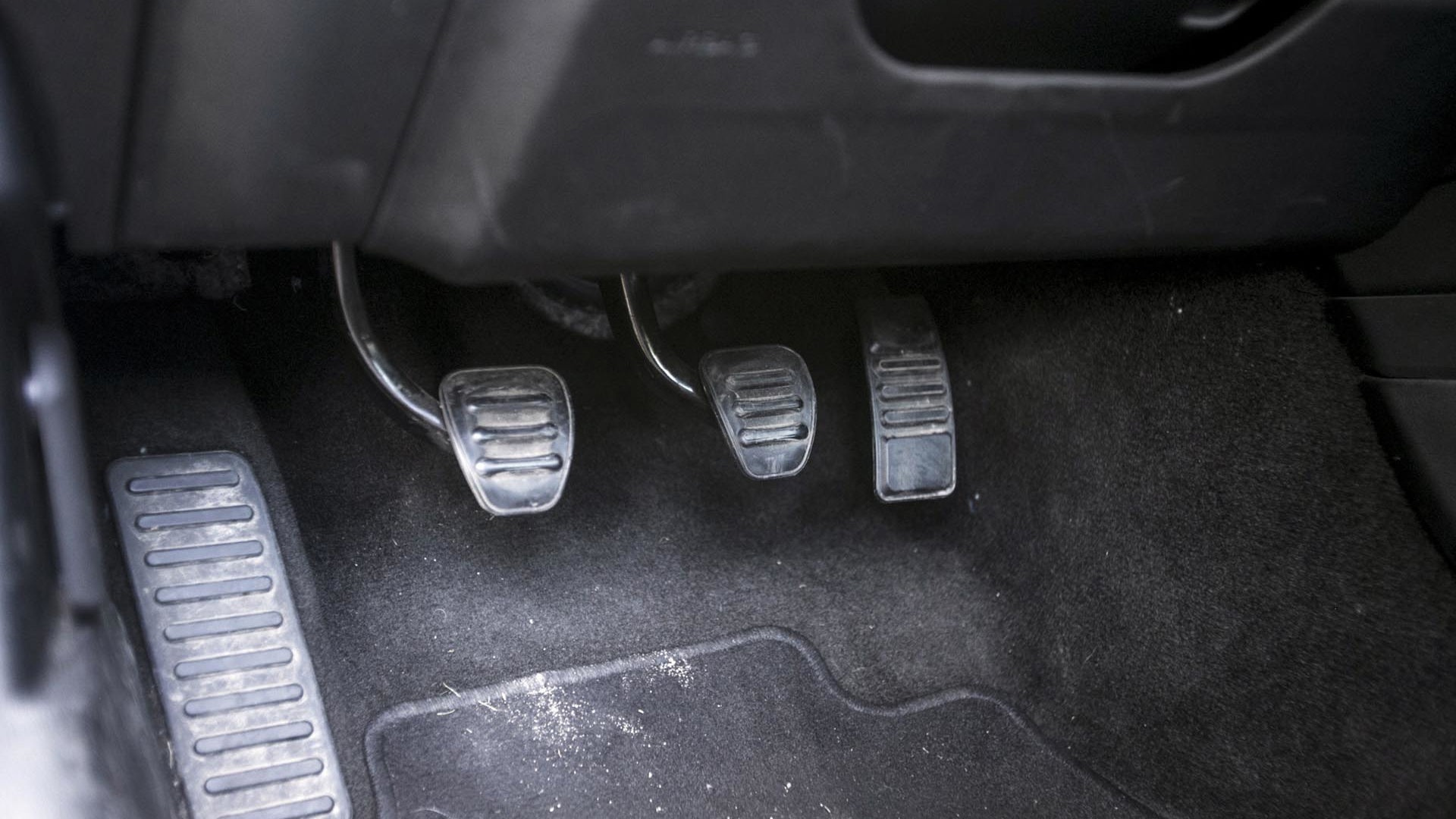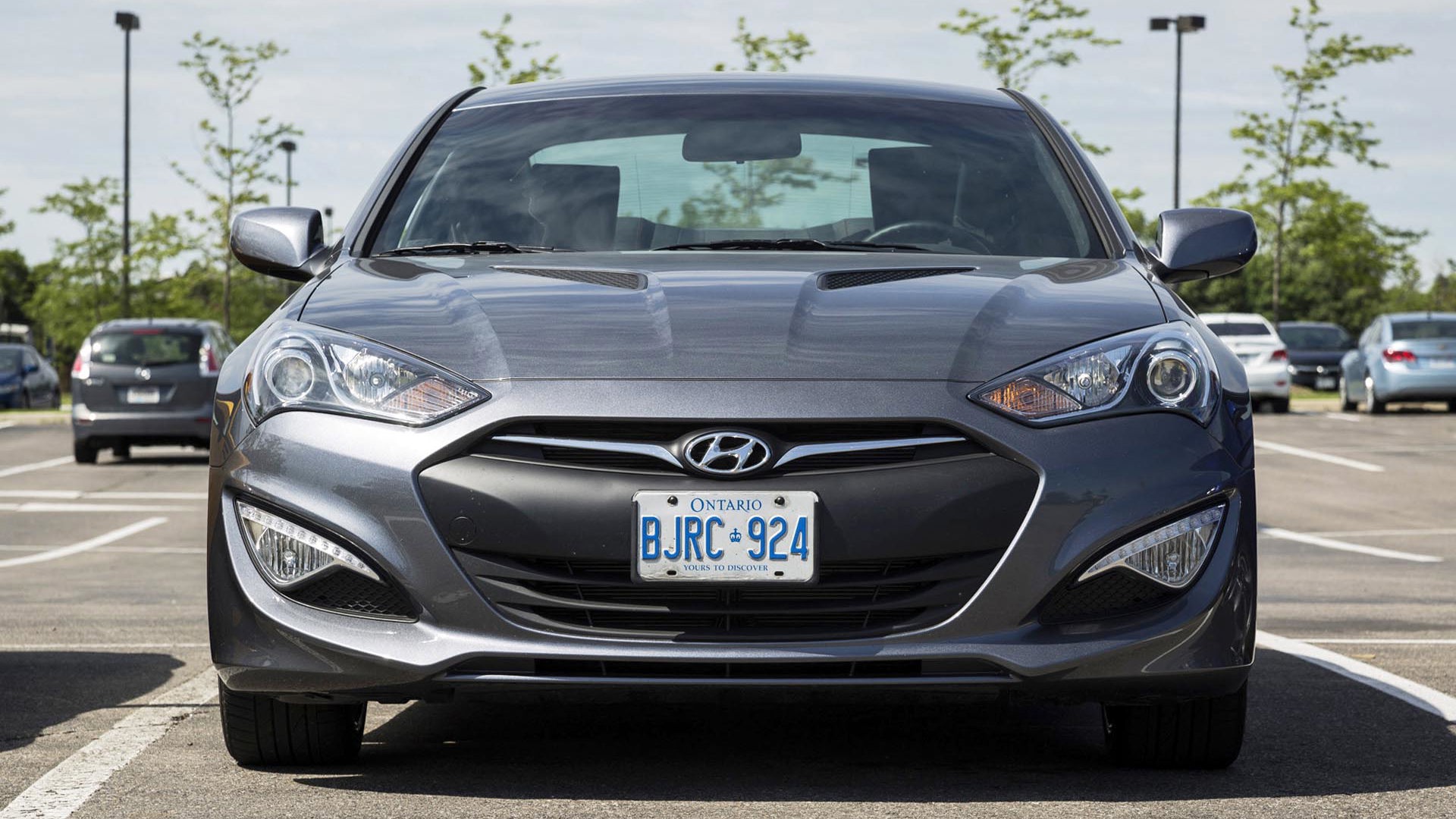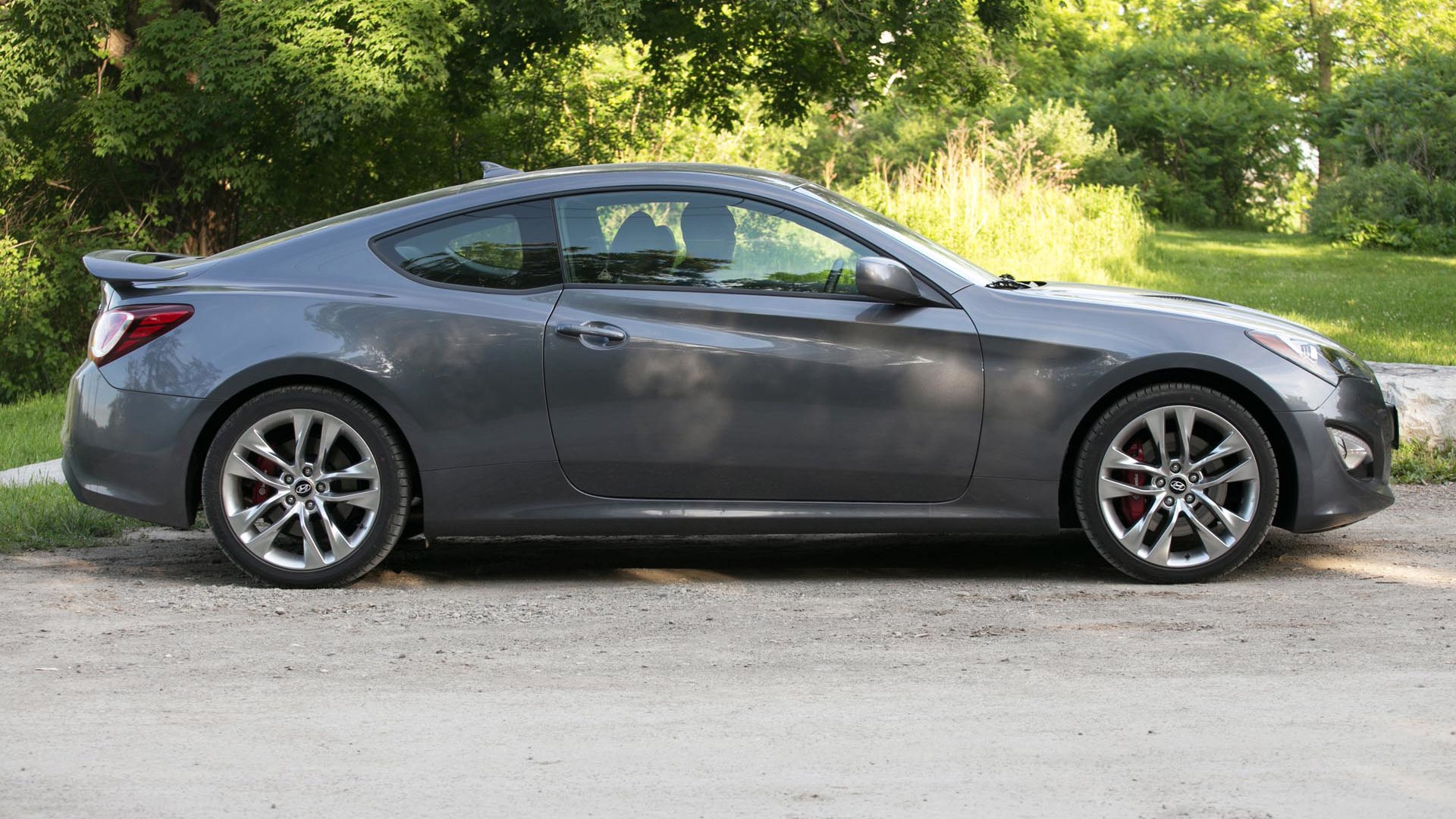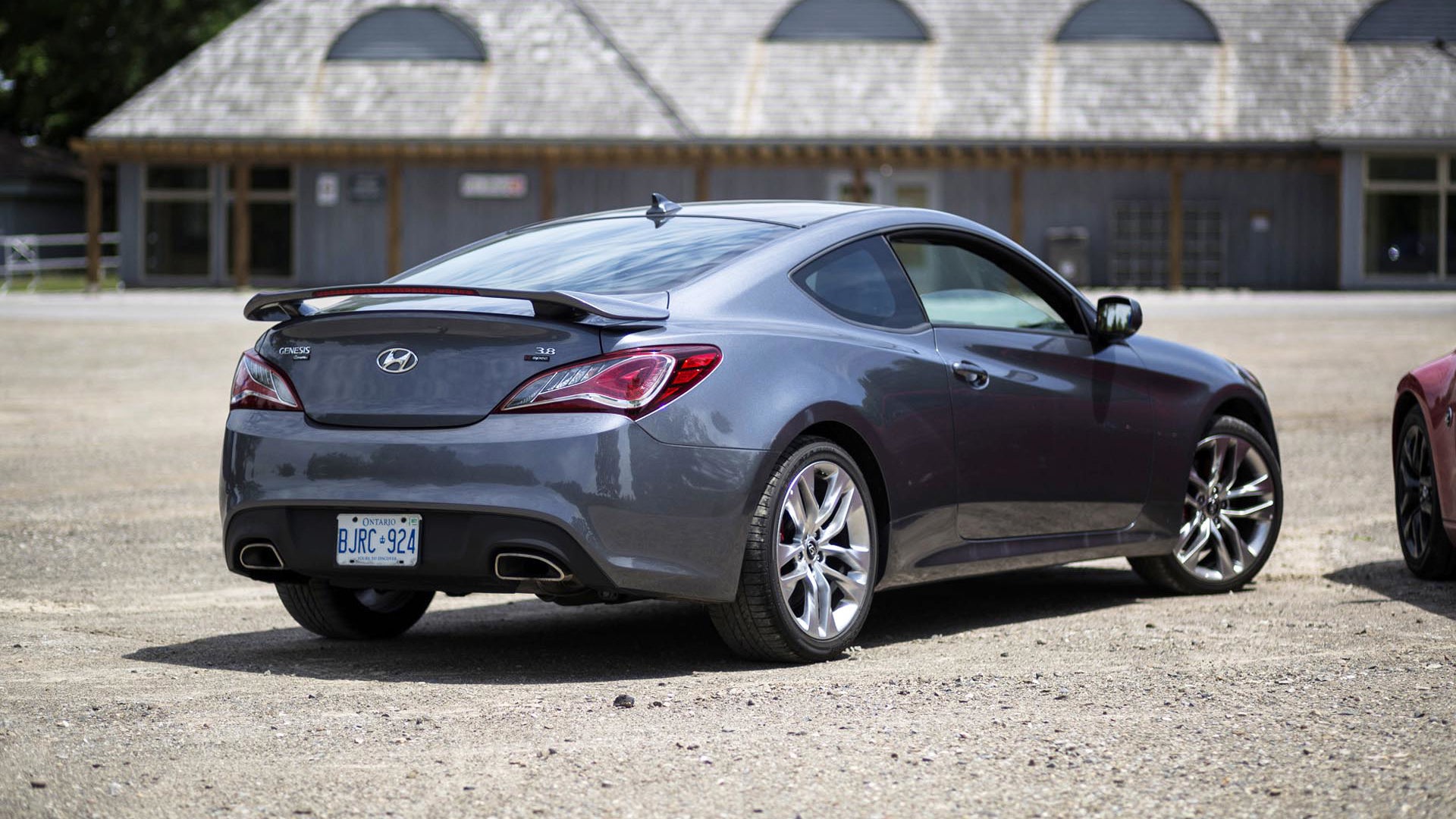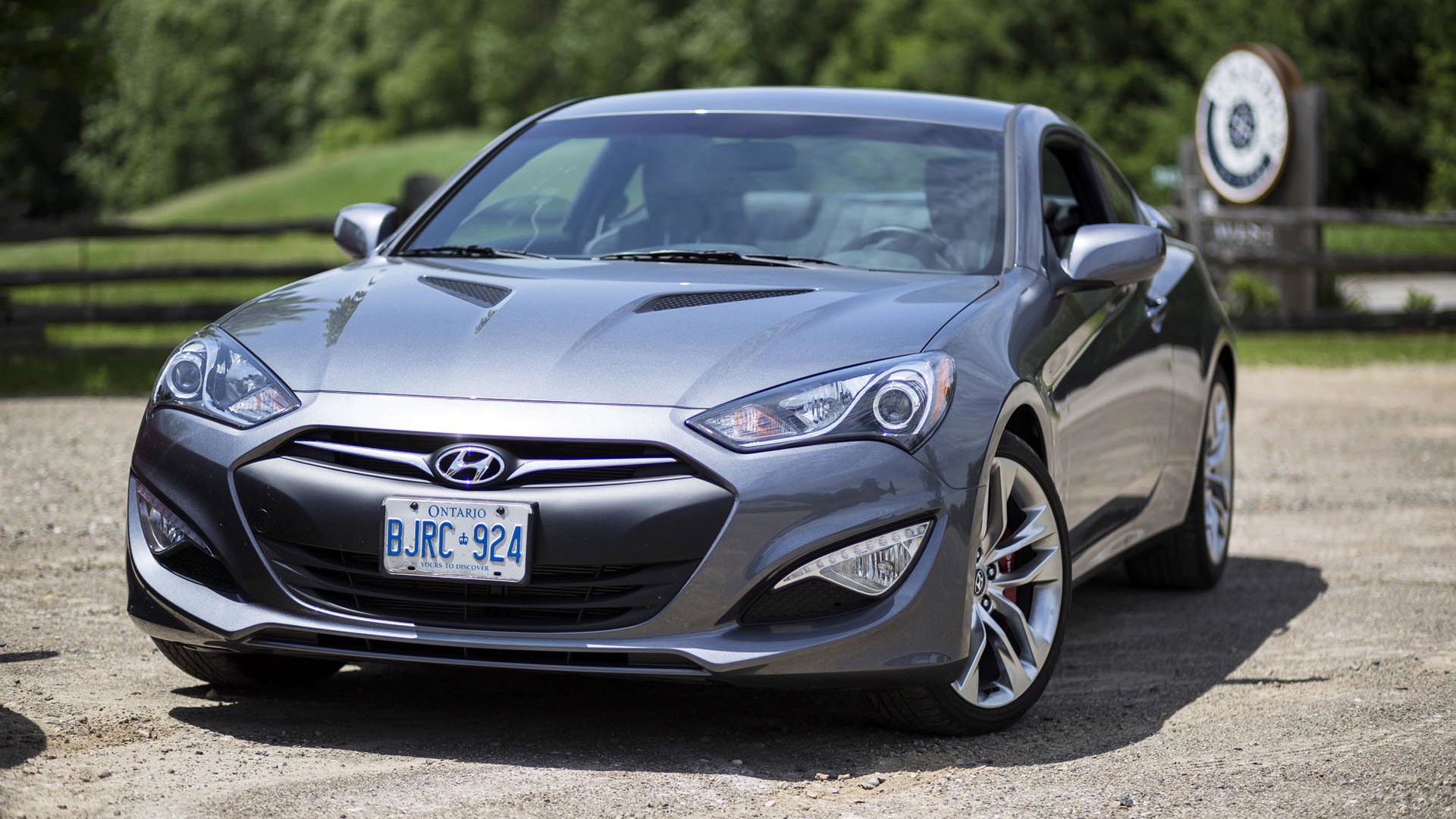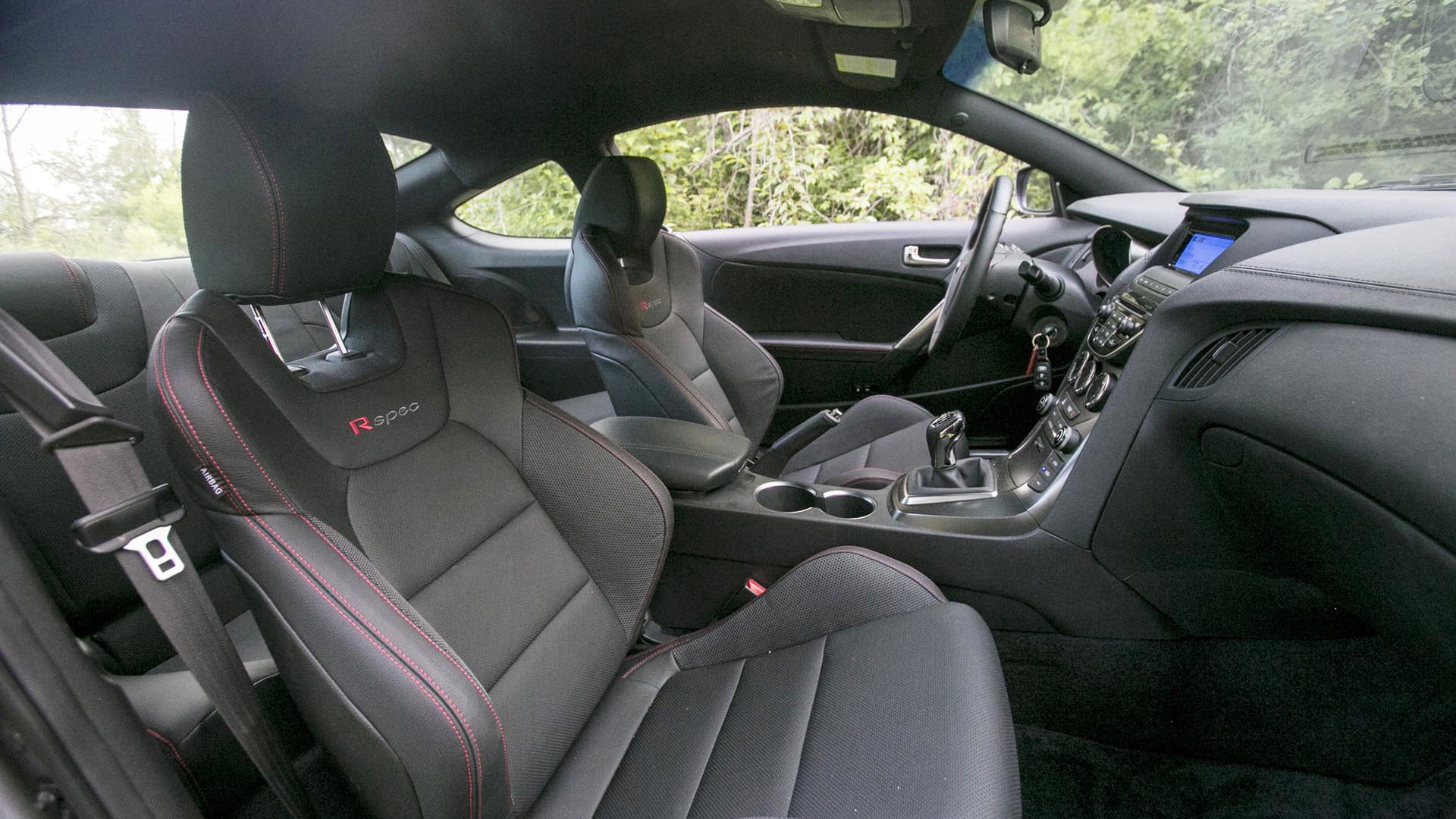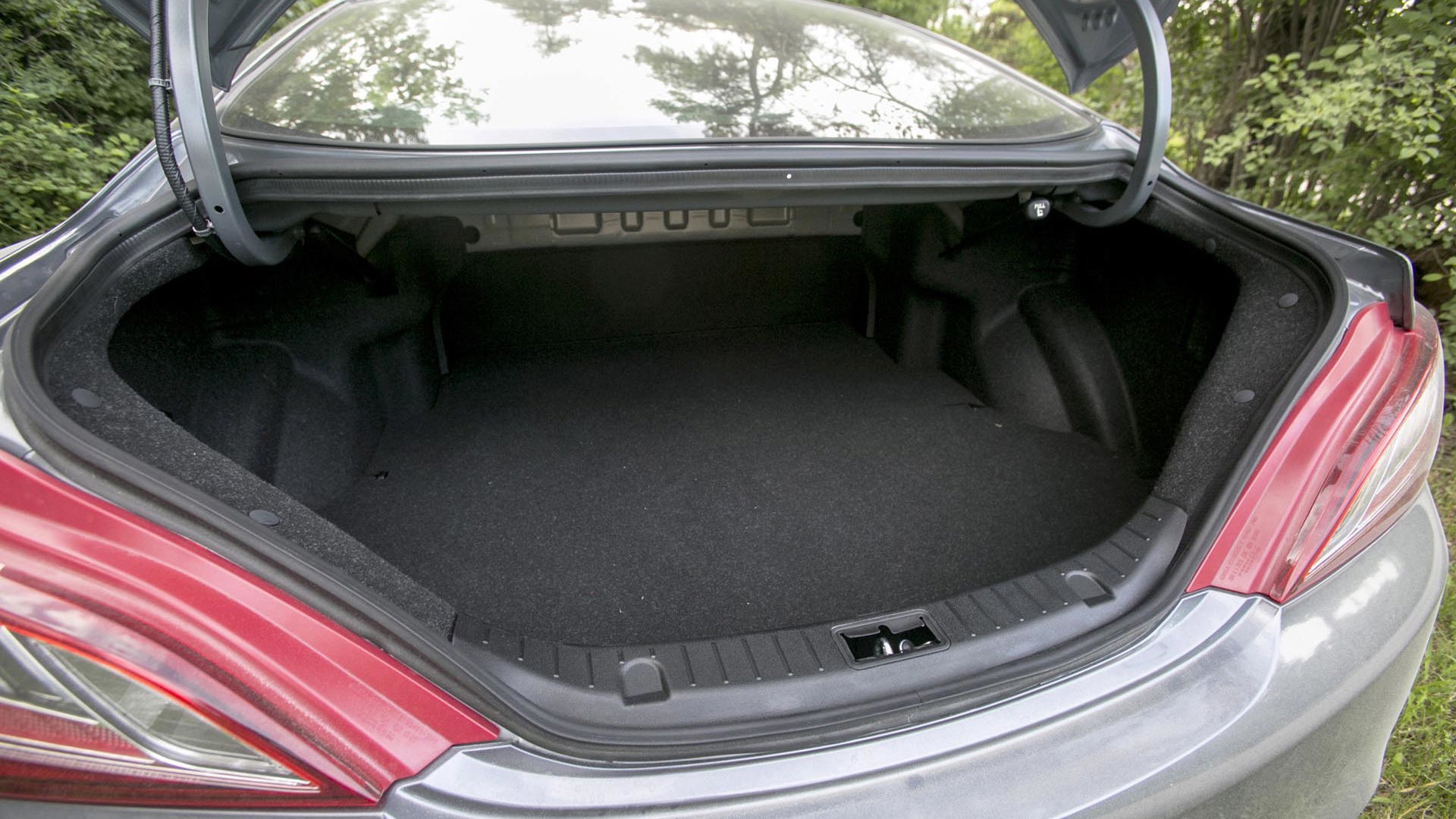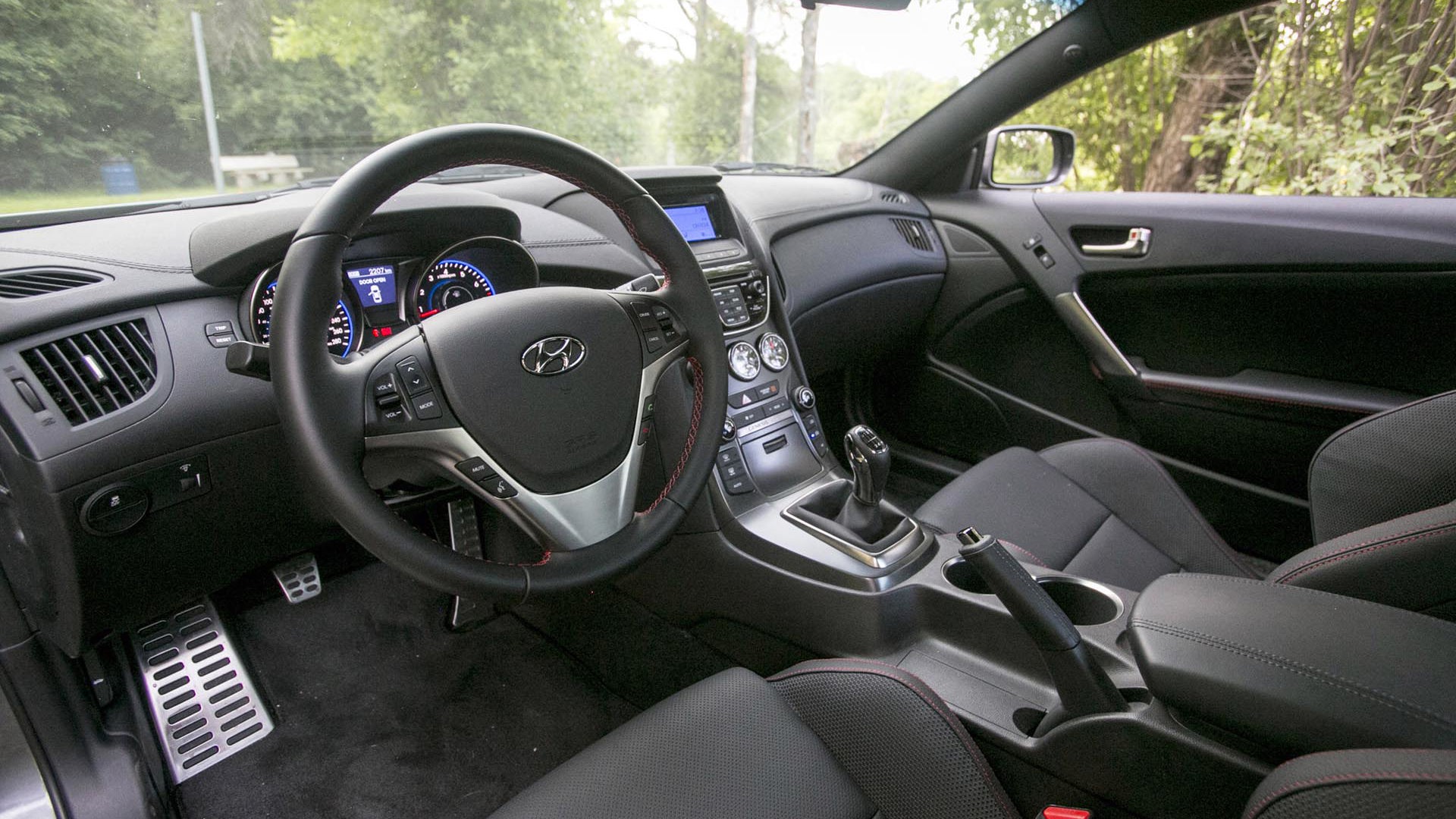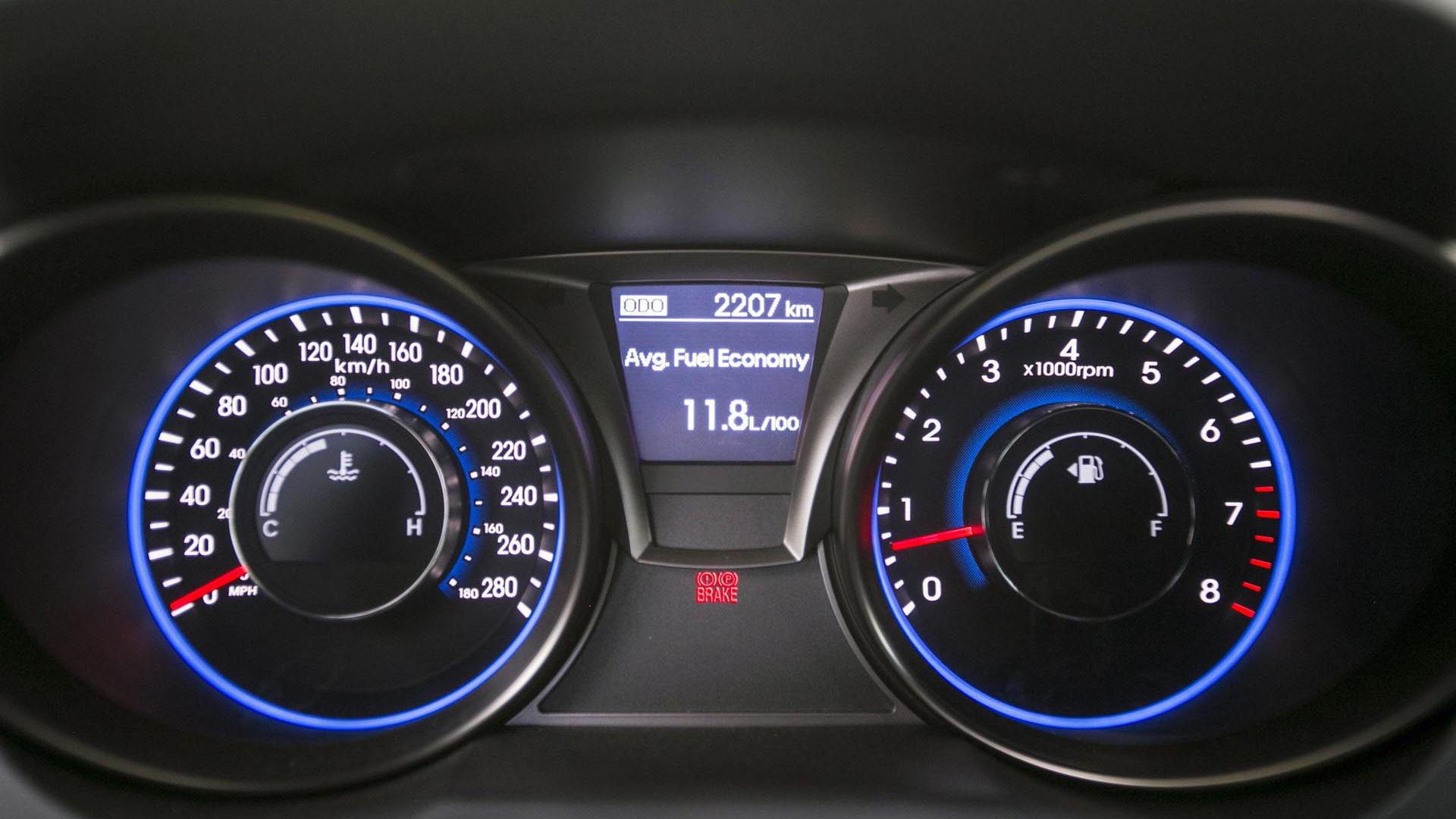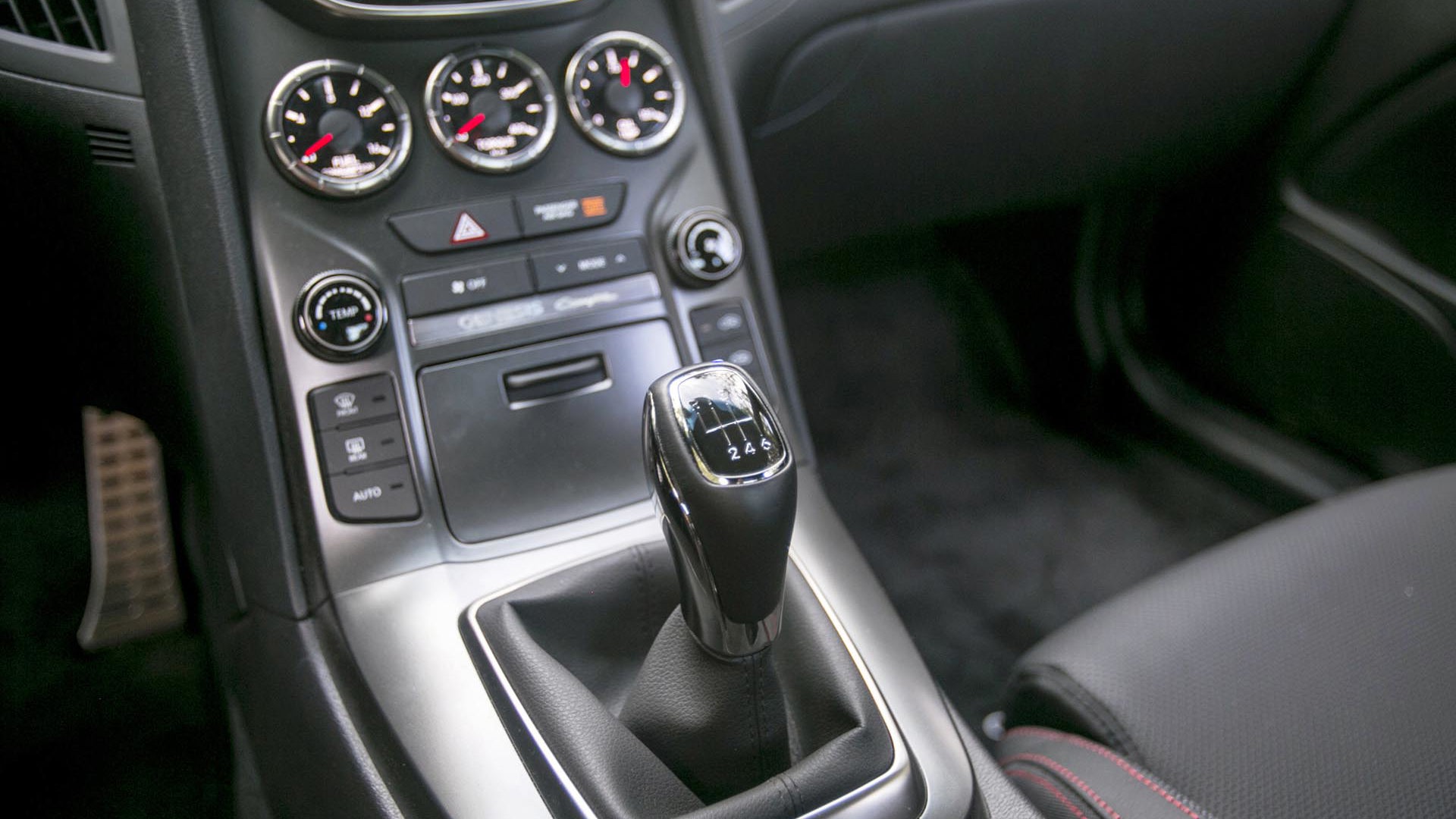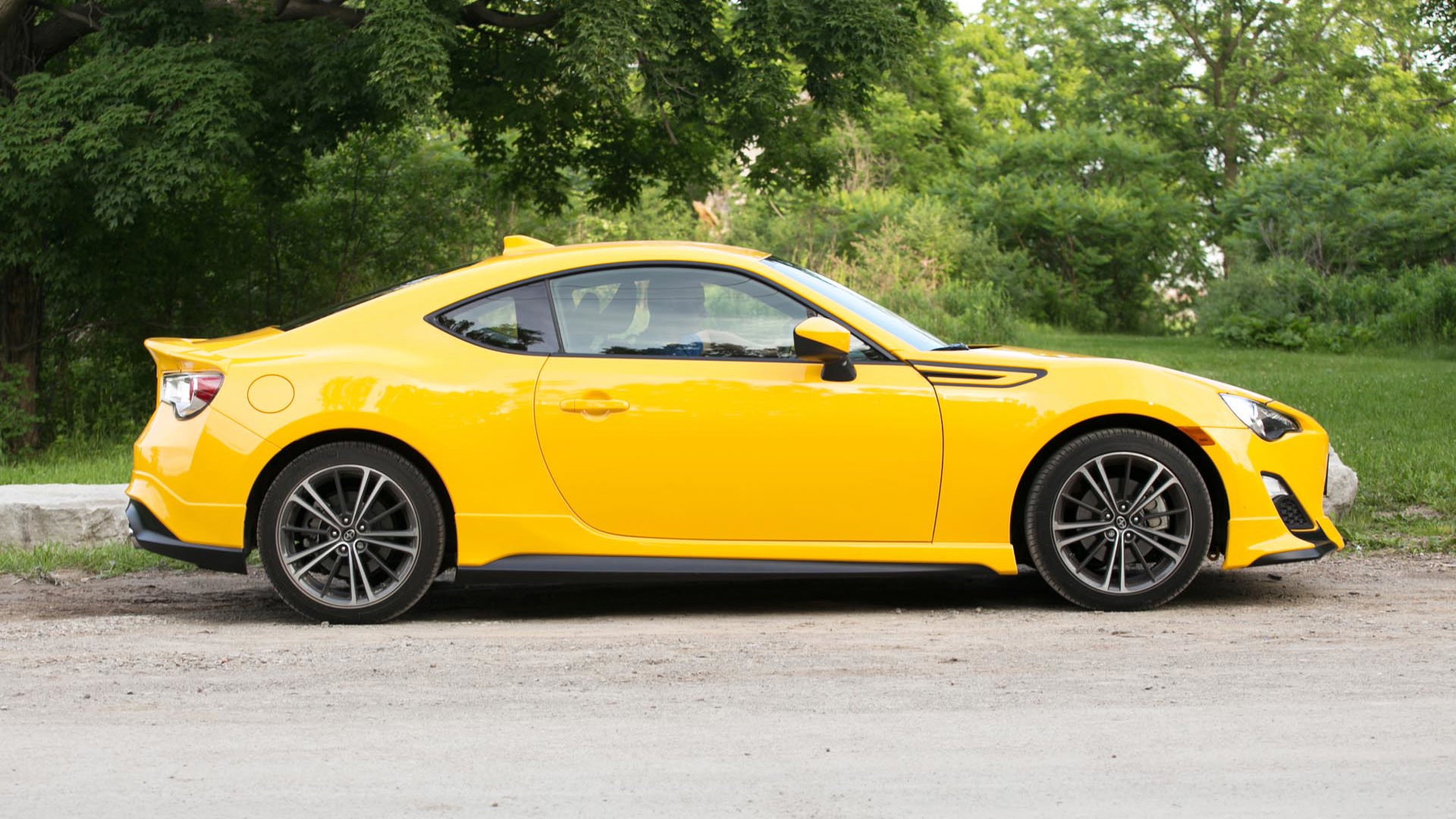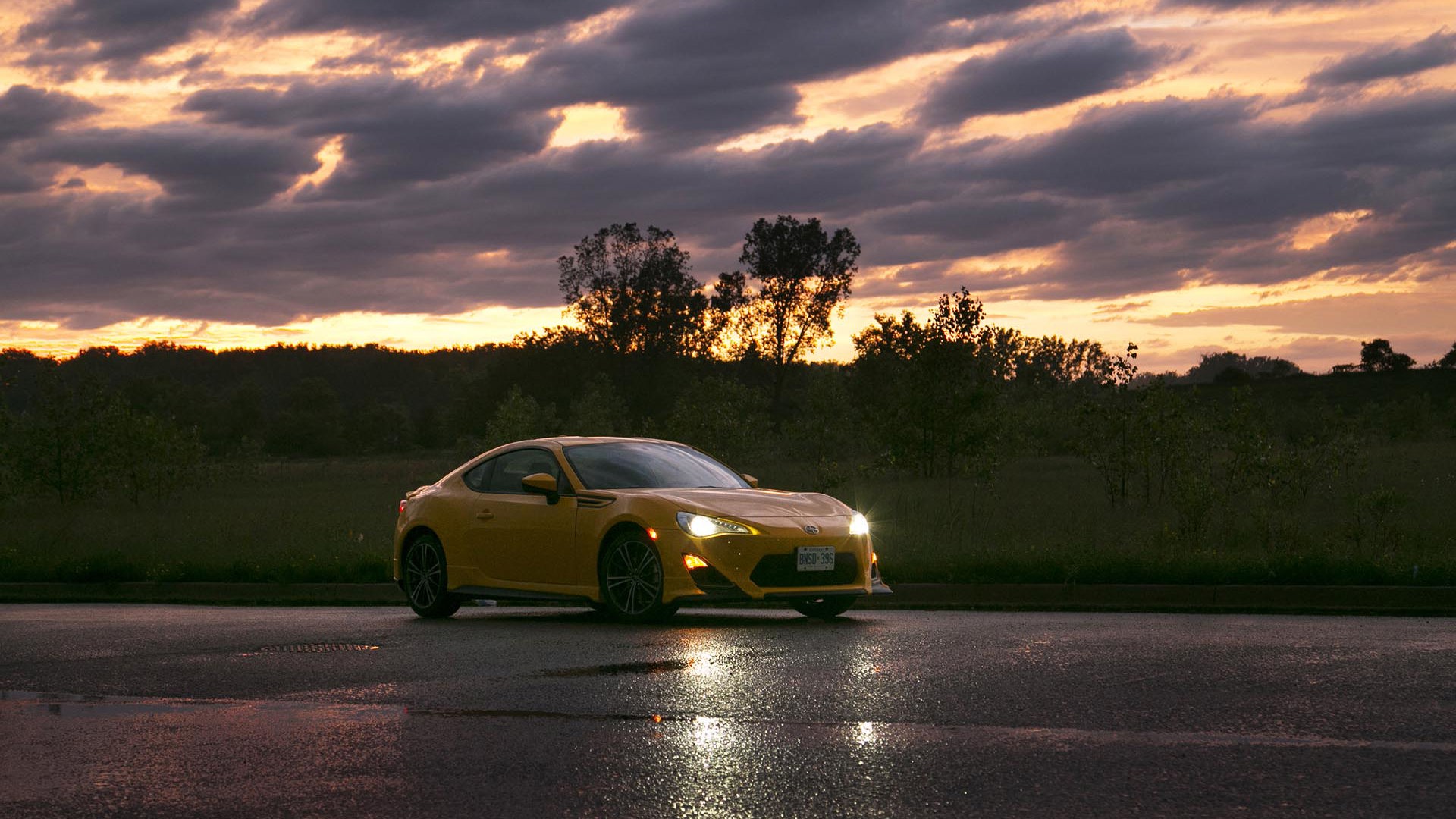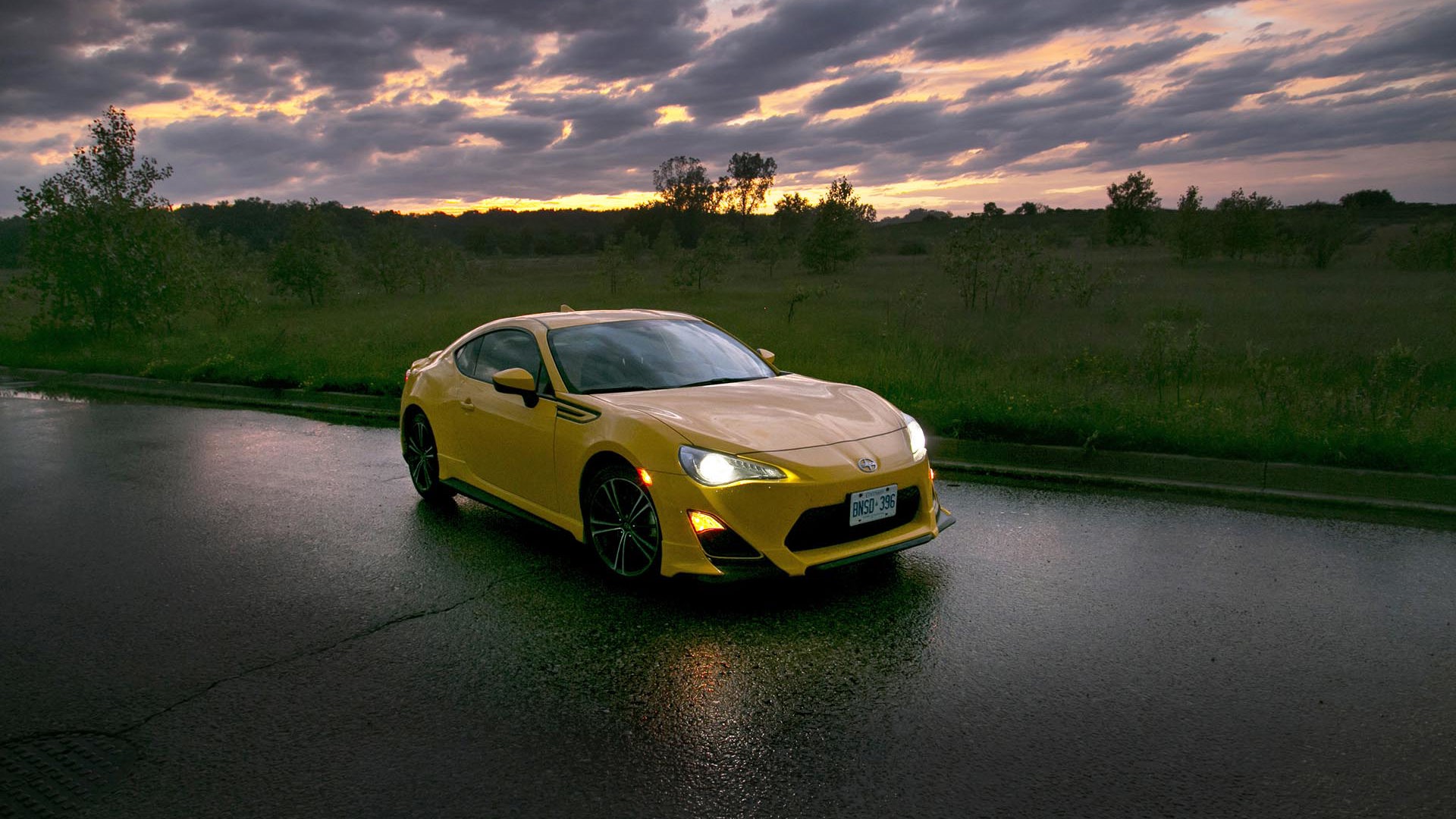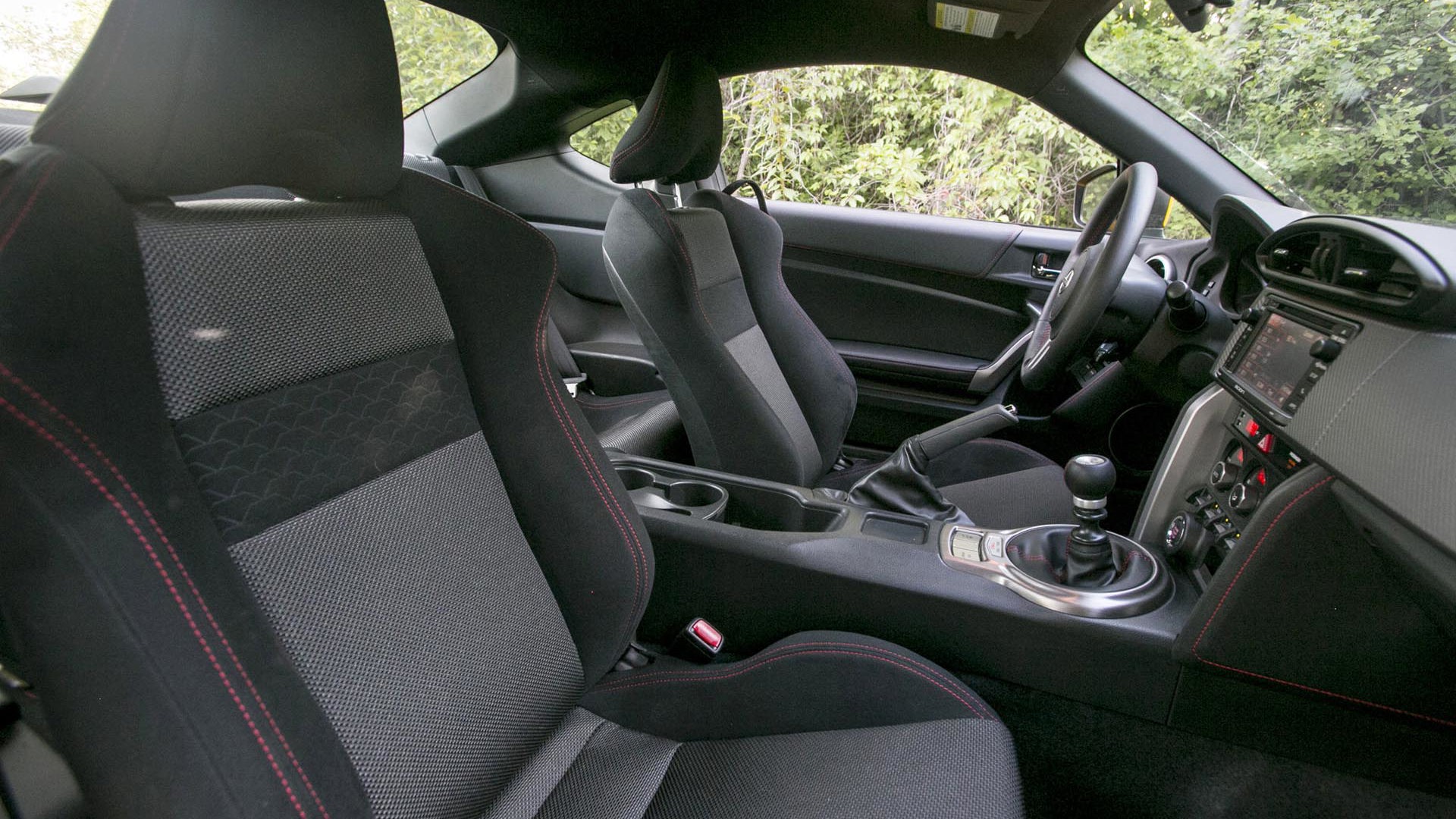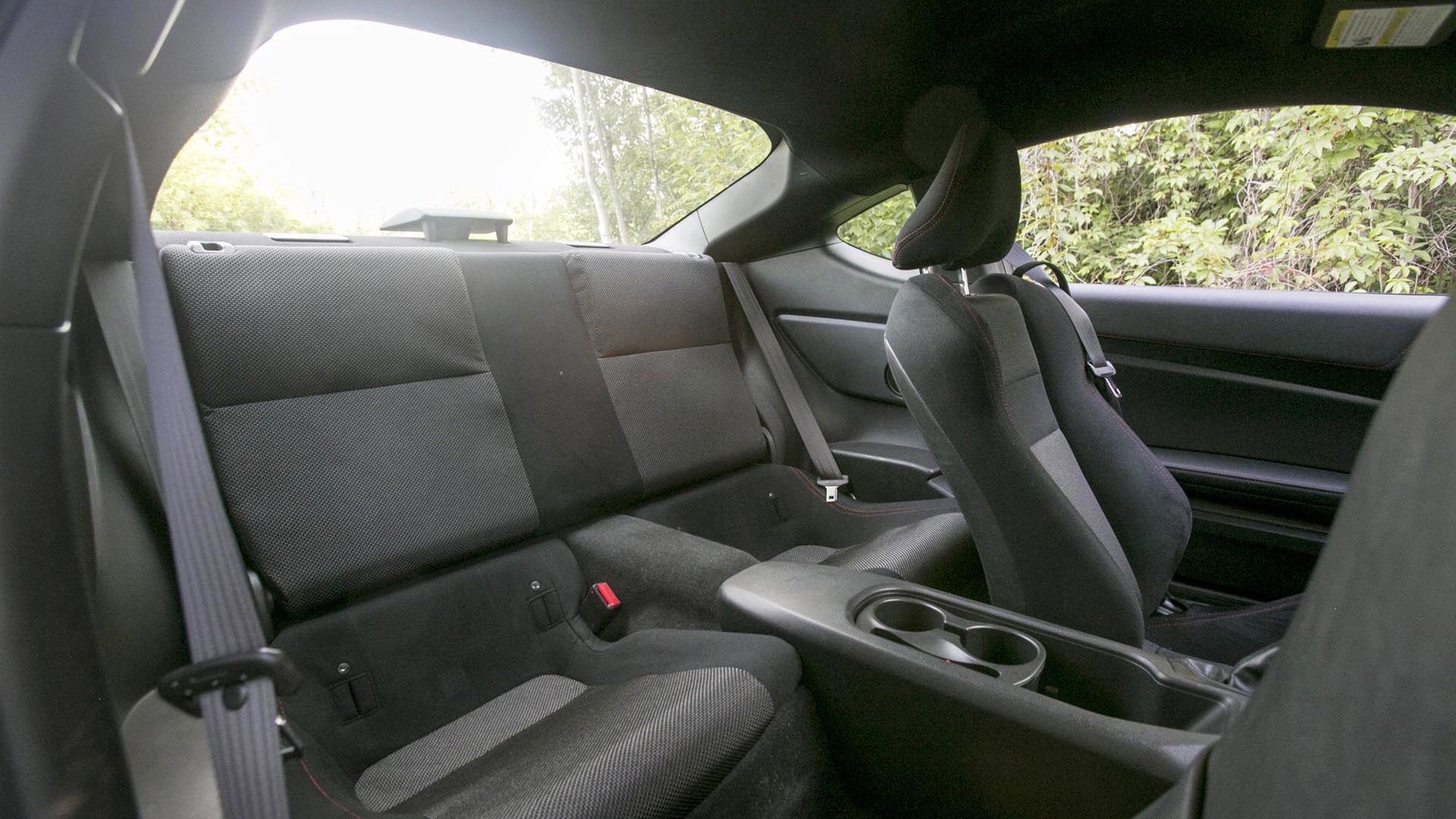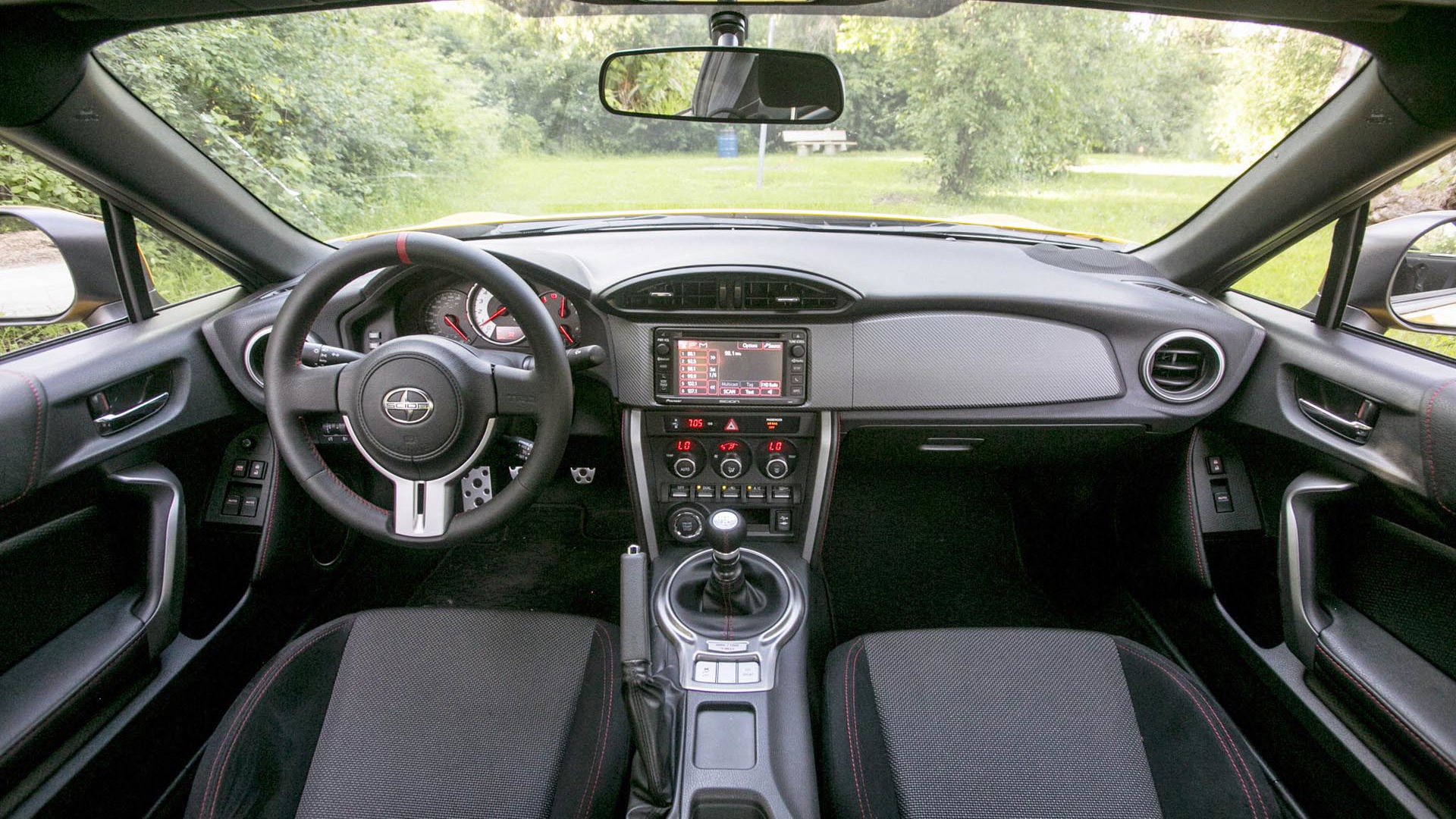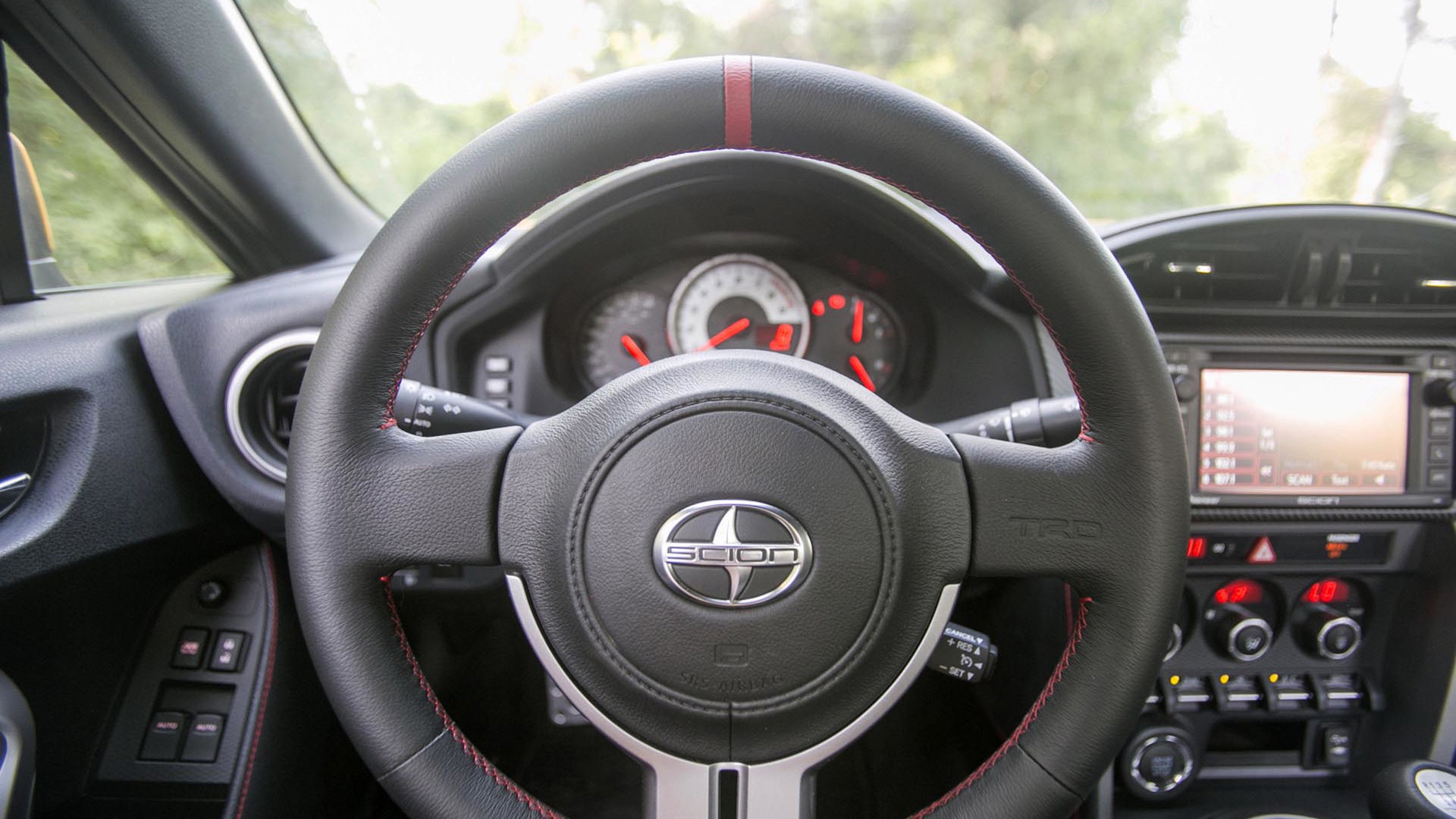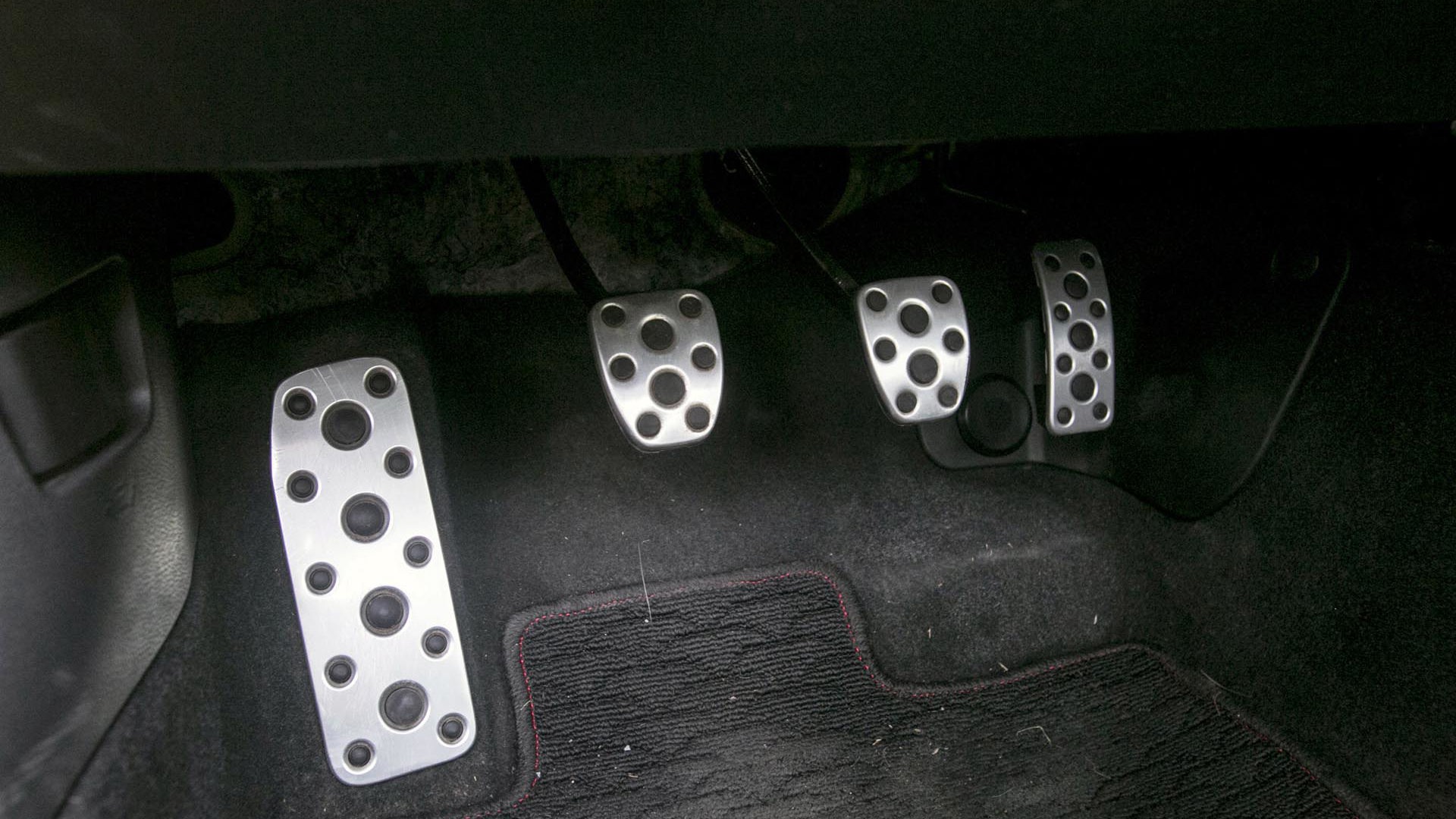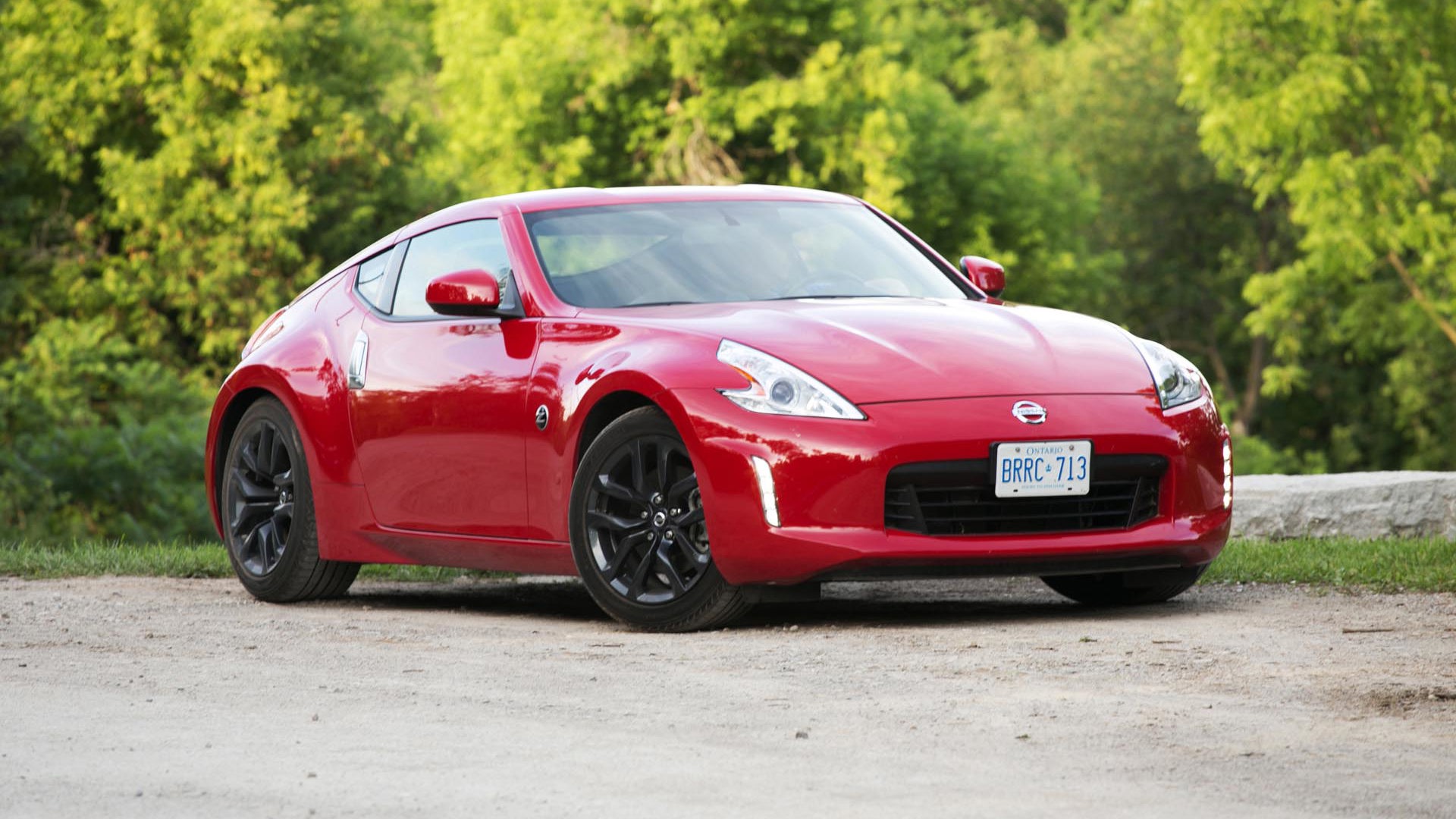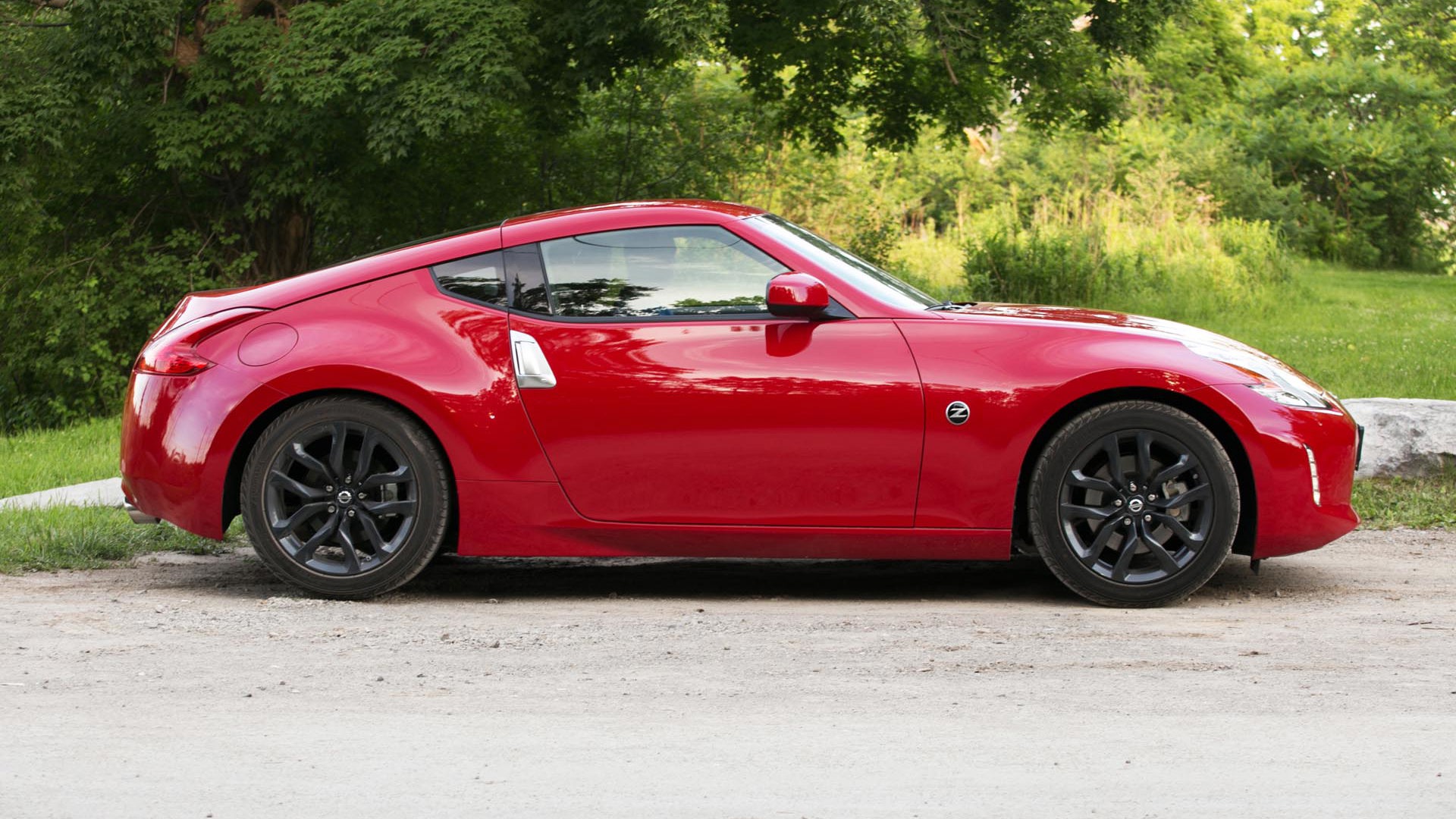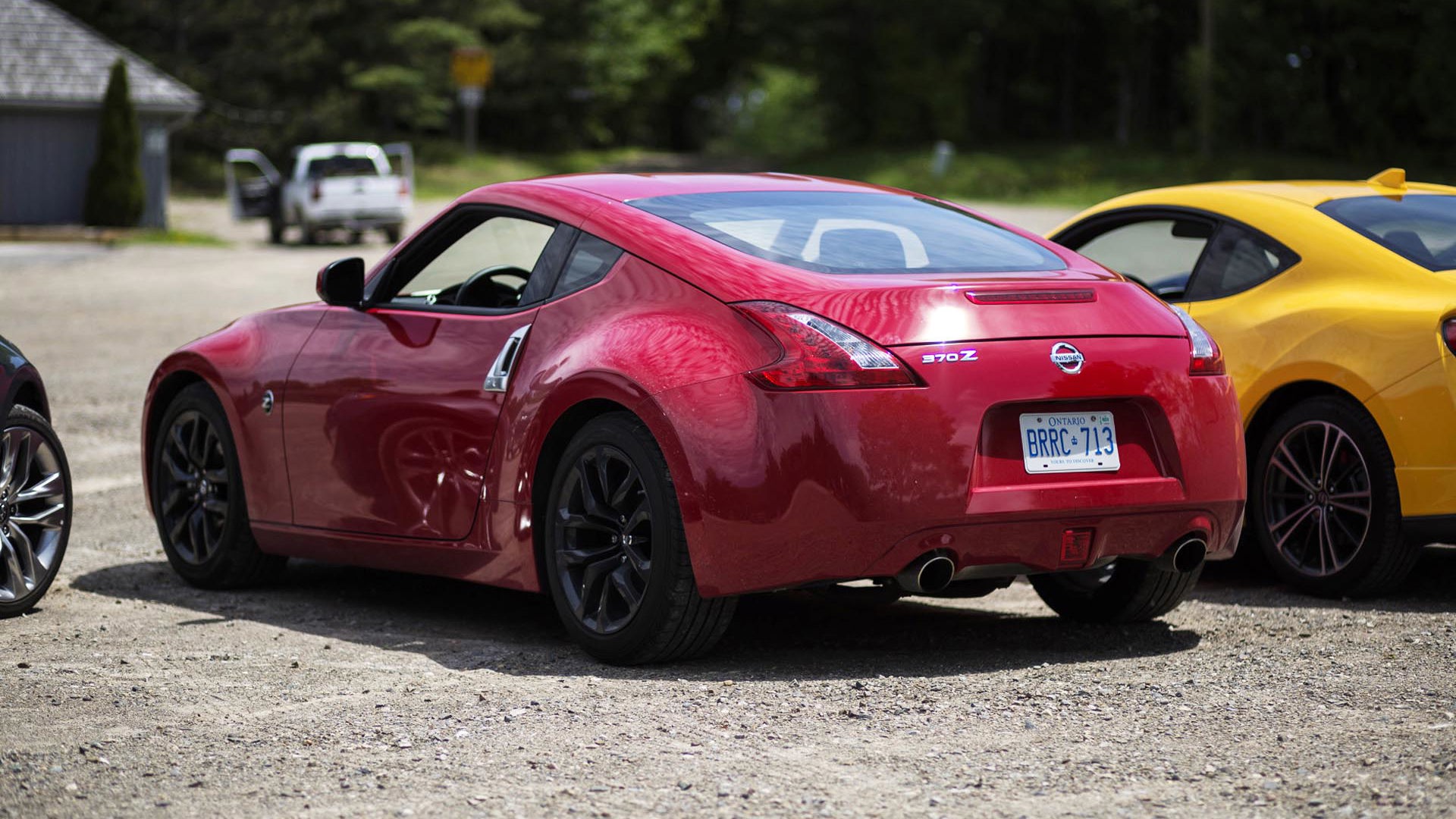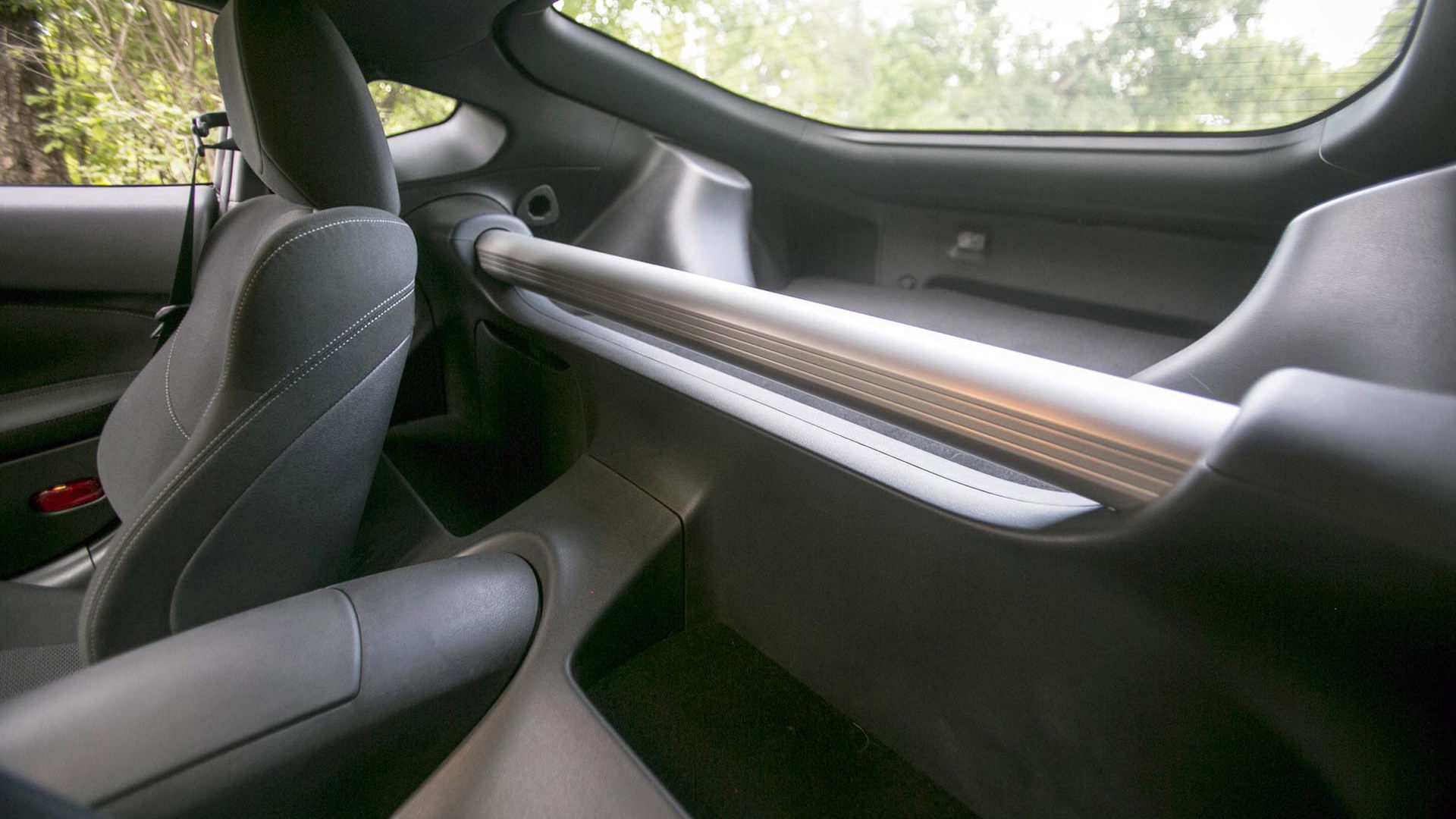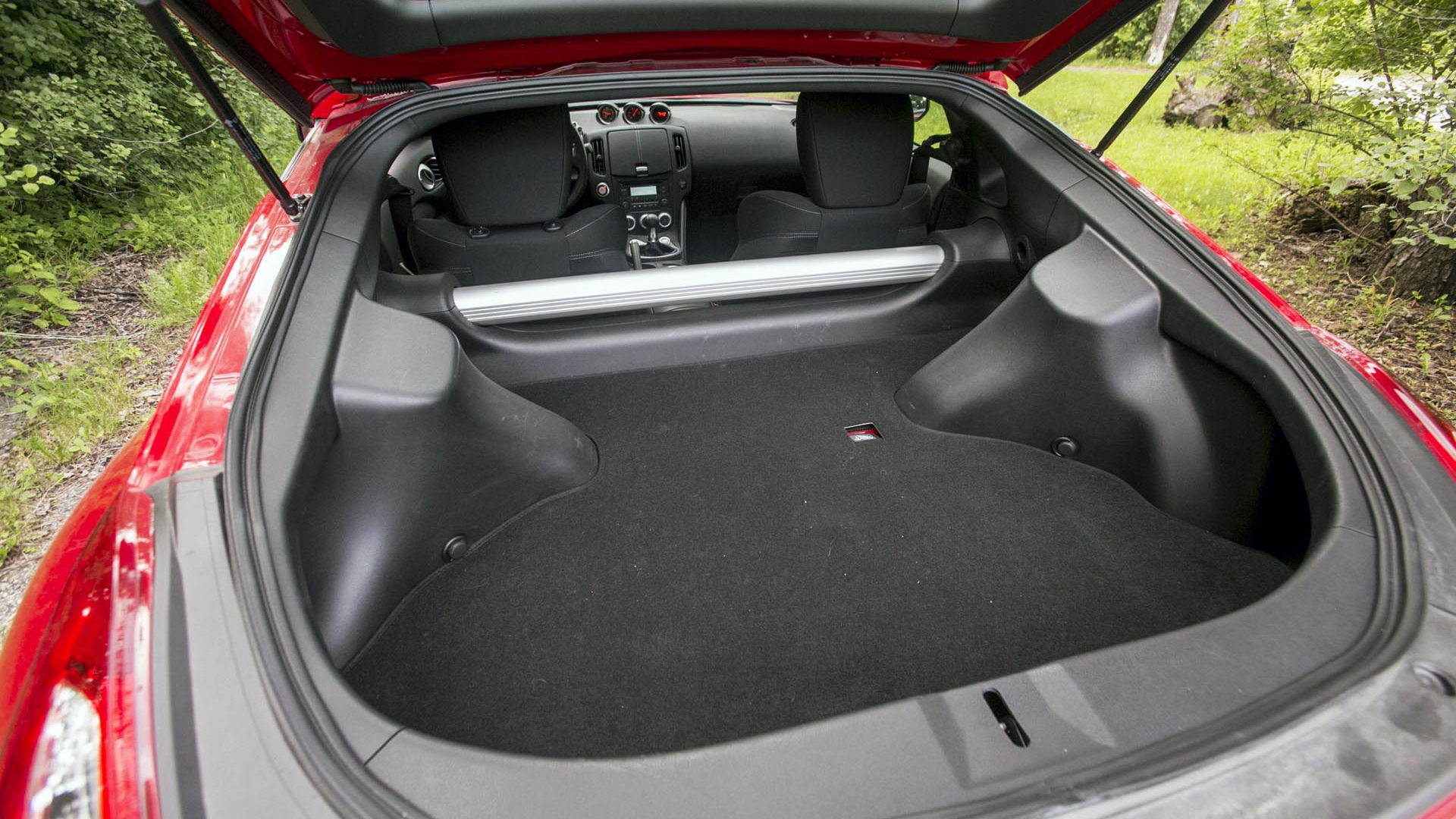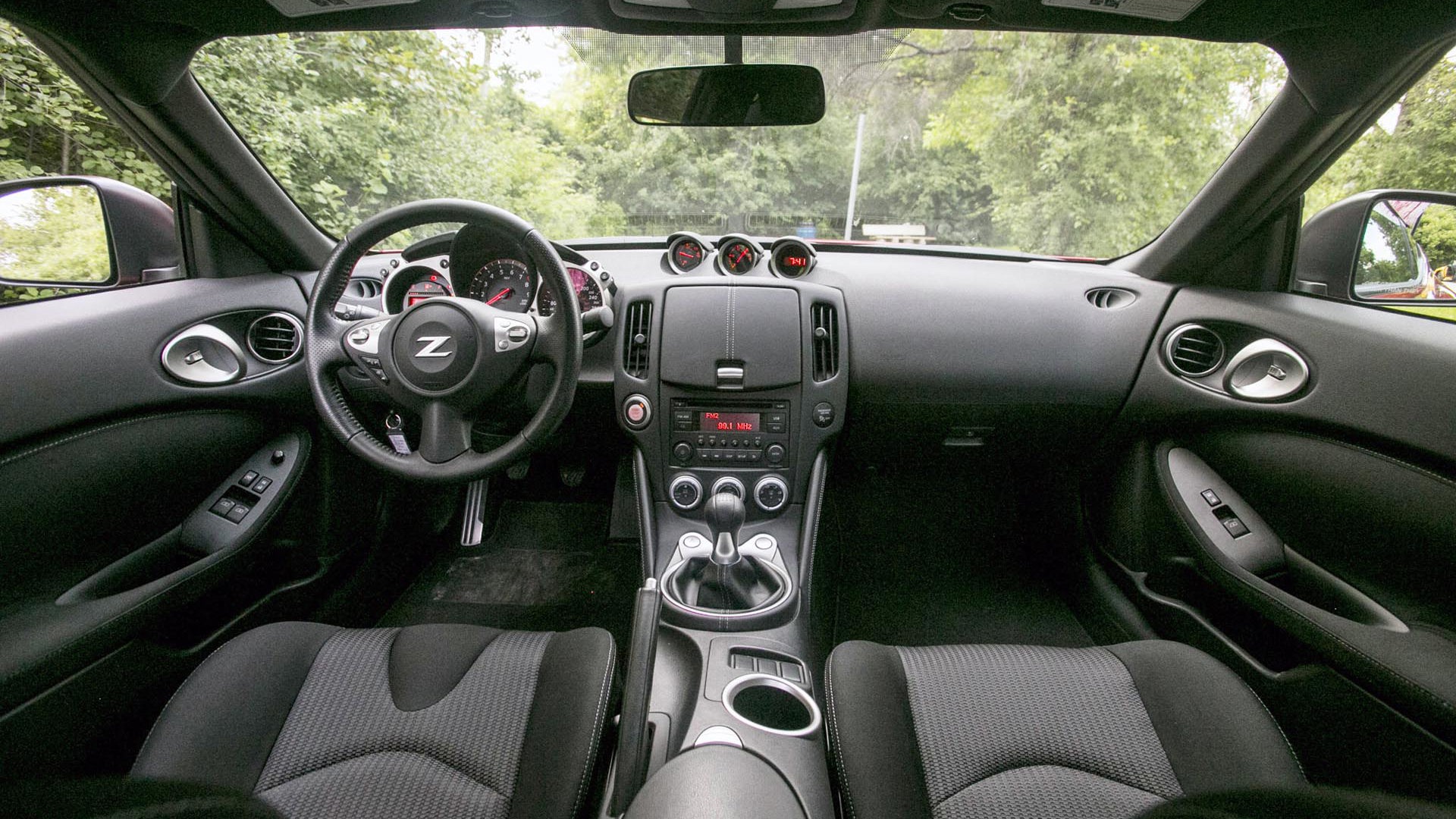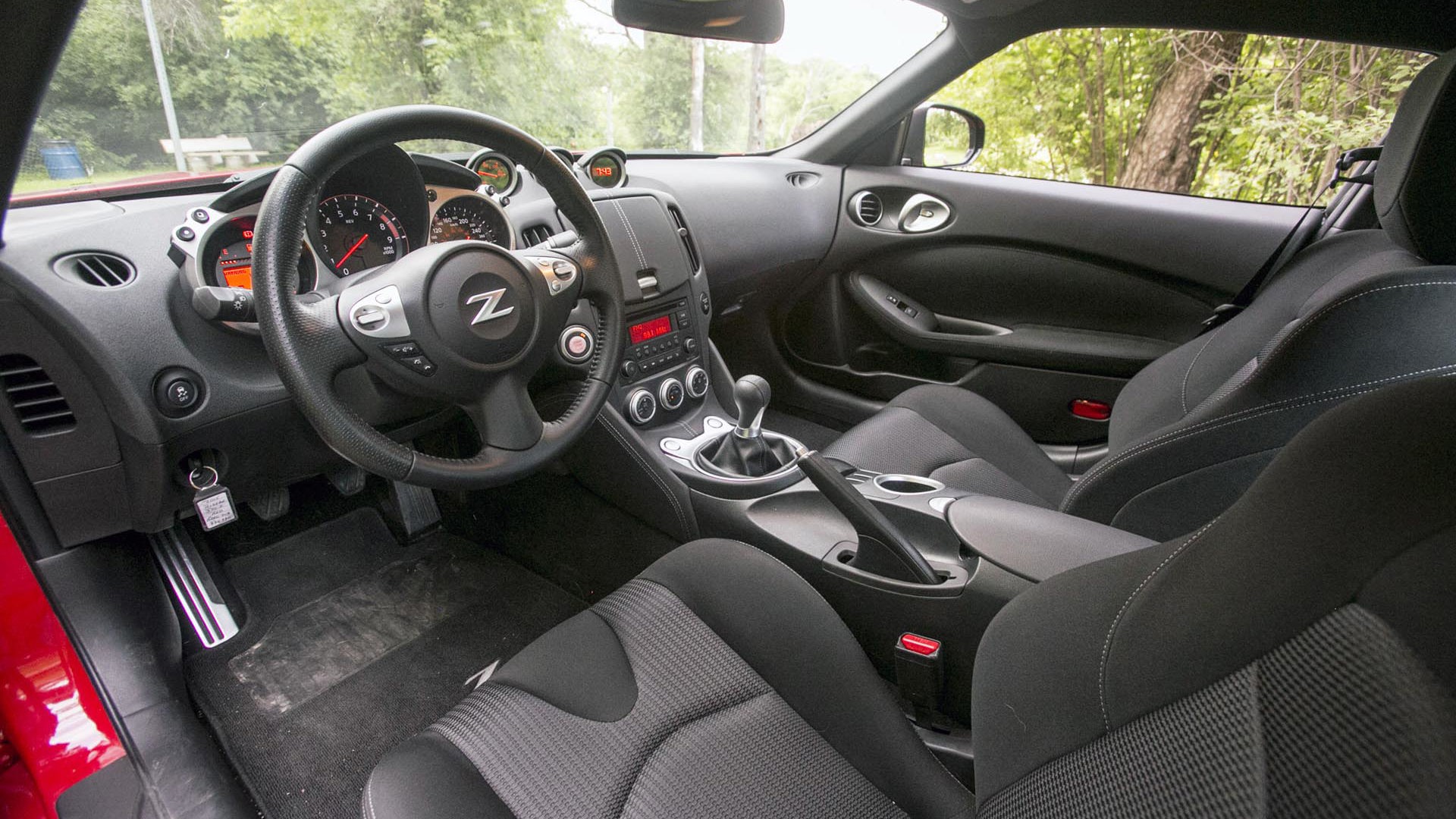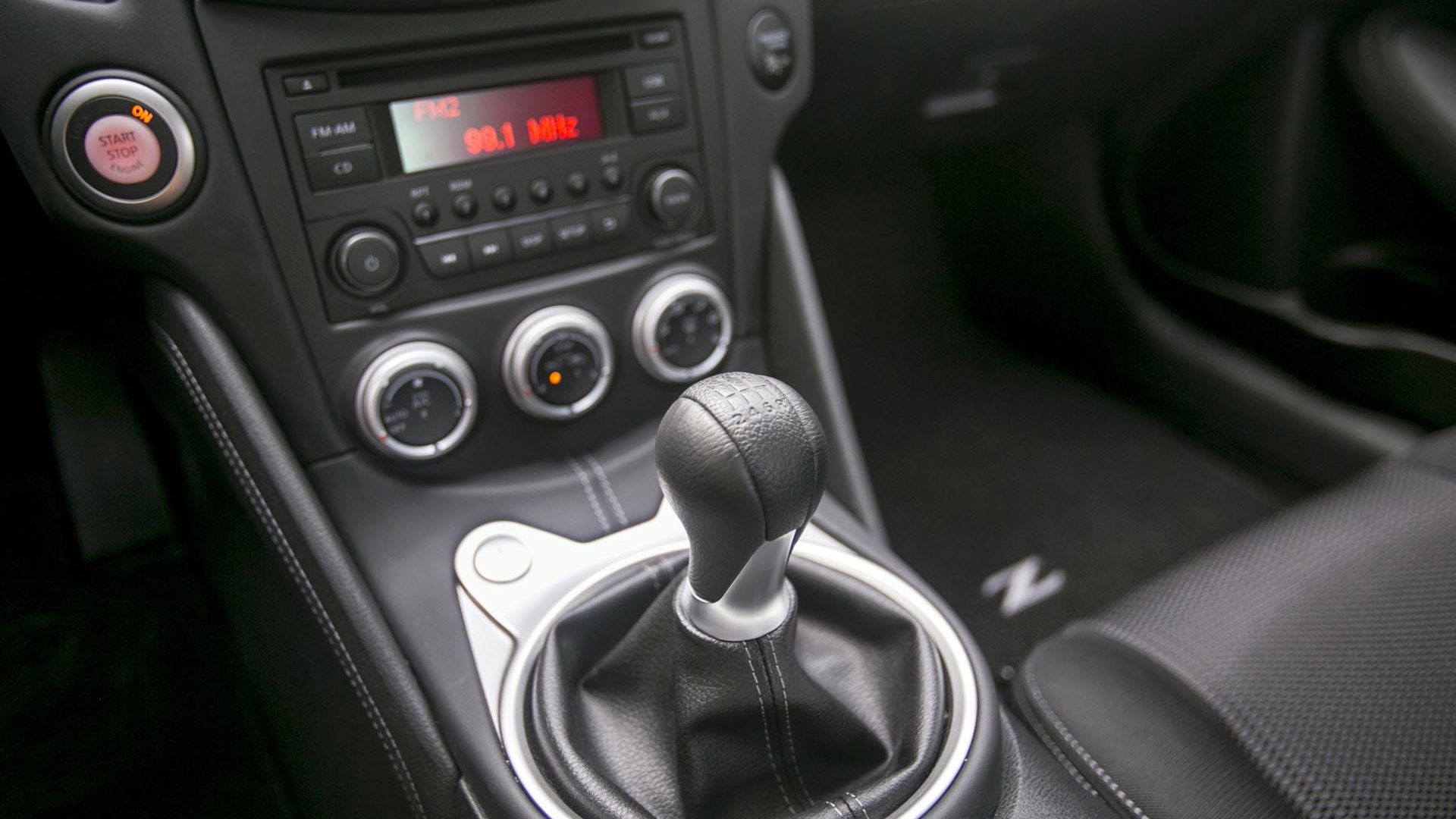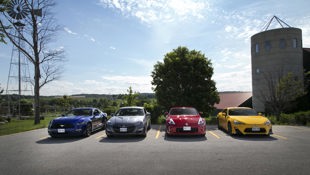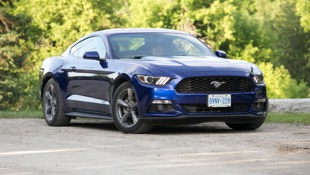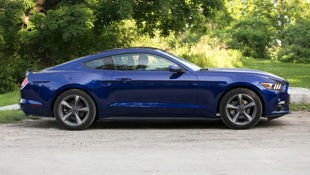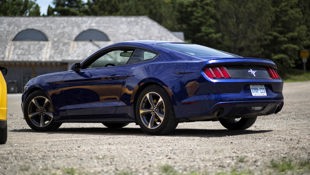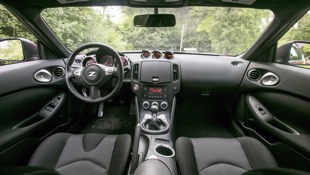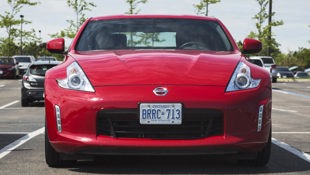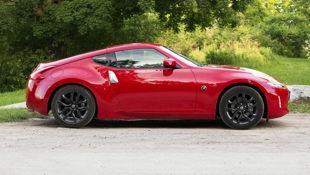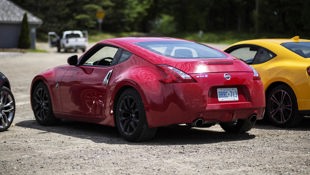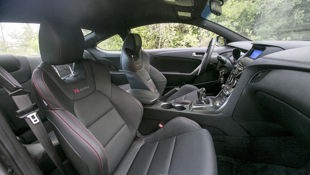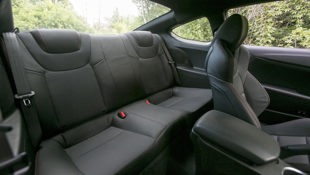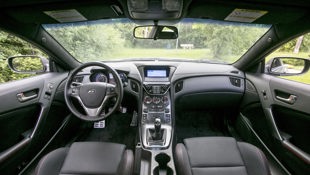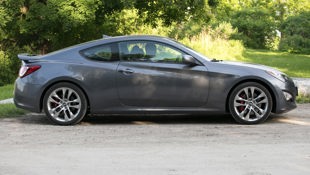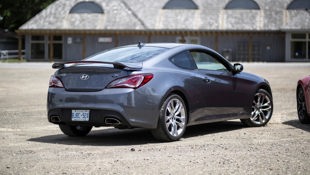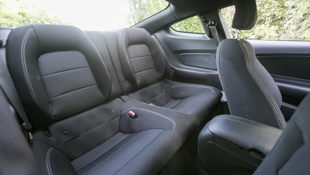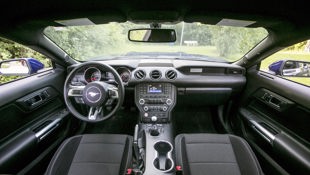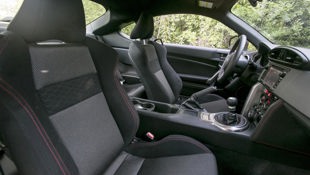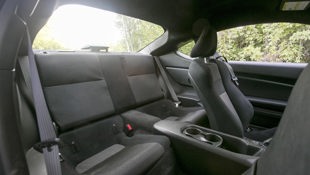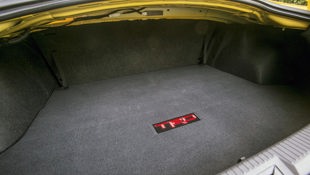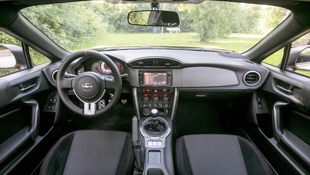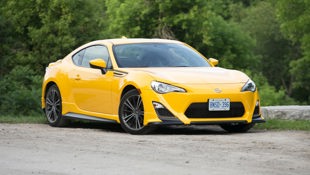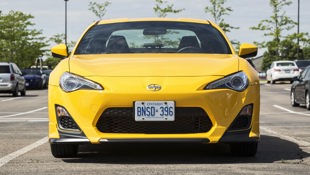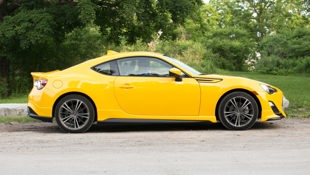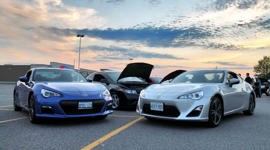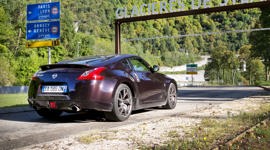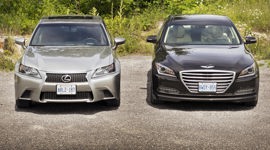Comparison Data
|
Base Price
$29,998
|
$29,499
|
$24,999
|
$32,565
|
|---|---|---|---|
|
Optional Equipment
None
|
None
|
18-inch aluminum wheels – $1,000, engine block heater – $150, security package – $700, reverse park assist – $350.
|
None
|
|
A/C Tax
$100
|
$100
|
$100
|
$100
|
|
Destination Fee
$1,740
|
$1,695
|
$1,600
|
$1,695
|
|
Price as Tested
$31,838
|
$31,294
|
$28,899
|
$34,360
|
Ford Mustang vs Nissan 370Z vs Hyundai Genesis Coupe vs Scion FR-S
Review by Jeff Wilson, Jonathan Yarkony and Ronnie Fung
Photos by Jeff Wilson and Ronnie Fung
Lordy, what a time to be alive!
Introduction, Jeff Wilson
Lordy, what a time to be alive!
Why, we can live-stream video chat from our phones with people around the planet. Scientists are preparing to send folks to Mars in our lifetime! And best of all, there are still a few great, simple and affordable rear-wheel-drive sports cars available in Canada!
For those of us faithfully praying at the altar of motoring purity, the four machines we have assembled here are among the best of what seemed to be a dying breed: cars that demand to be driven. Naturally, they do have all the mandated safety nannies – antilock brakes, traction and stability control systems and more inflatable surface area than a bouncy castle, but by golly, if you want to, you can steer these things with your right foot, and if you keep that foot planted hard enough you can vaporize a set of rear tires in a long and lurid smoke show. Okay, except maybe the FR-S.
Of course that would be gratuitous and not at all what we’re here to do. Rather, we’re looking to celebrate that all four of these cars can be purchased by folks with modest incomes. We’re applauding their sassy appearances compared to utilitarian-looking hot hatchbacks and frumpy little sedans. And most of all, we give praise that these machines send power to the wheels at the back, enabling purer, unencumbered steering up front and honest-to-goodness manual transmissions to choose your own gear while doing so.
It’s like a miracle from above that’s given us these soulful machines, back from the brink of extinction.
Praise be!
Ford’s new Mustang has always played in this field with an affordable basic entry. Historically, those beginner-level Mustangs were better suited for rental fleets than race tracks, but they sold well and soldiered on. While the new 2015 Mustang has generated loads of positive press this year largely around its new turbocharged EcoBoost and V8 GT Mustangs, even our cheap-as-chips V6 coupe packs 300 horsepower of punch.
Meanwhile, Nissan whacked ten grand off the entry price for a 370Z this year, discarding frivolity and content to make this the lowest-cost Z-car since the 1980s. It also gives Canadian enthusiasts exactly what they’ve wished for since the 370Z launched six years ago: an attainable Z.
After 2014, Hyundai put their affordable, turbocharged four-cylinder Genesis Coupe out to pasture, causing enthusiasts to get their torches and pitchforks ready. Then redemption: Hyundai turned around and rejigged the content to make the purest, most sporting Genny Coupe ever with the 3.8 R-Spec you see here. In the process the Koreans have also earned the bragging rights of offering the most powerful car in Canada for less than $30,000.
And Scion? Well they added a new body kit and a noisy exhaust this year to their diminutive FR-S coupe. We’ve always loved the FR-S and its Subaru BRZ twin, so they were given an invitation to this cheap thrills party despite earning no better than fifth place in last year’s Affordable Fun Cars Comparison Test.
At the end of a long but glorious and sunny day of driving through the Forks of the Credit and Hockley Valley, onward to a delicious lunch in Creemore, Ontario (and lots more driving), none of our evaluators could foretell which car our test sheet numbers would reveal as the winner. Each of these sporty coupes has its charms and its weaknesses, and drivers everywhere are better off that all of these great machines are currently for sale.
With an all-new Chevrolet Camaro and Mazda MX-5 hitting showrooms soon too, you can bet the best of this test will have those new contenders to answer to in the coming months. We can’t wait for that next comparison, but in the meantime, here’s what we found out about these four.
4th Place: 2016 Nissan 370Z, Ronnie Fung
When the almighty Z badge was resurrected on the trunk and fender of the 350Z in the summer of 2002, it proved Nissan still knew how to make a fun, good-looking, capable, soulful machine.
The current 370Z was released in 2009 in North America, and it was an all-new machine, and, unlike almost every other car that was gaining size and weight, was actually lighter, smaller, and wider than the 350Z. It was stiffer, by a significant amount, and the front double-wishbone suspension with forged aluminum control arms and steering knuckle and rear multi-link suspension with forged aluminum upper control arms made the 370Z even more capable than the 350Z. It was breathtakingly fast around the road course, chock full of techno-gadets, had a racy feel to the cockpit and just oozed sex appeal. It was a track-day hero.
A short five years later, and many chances to drive some dizzying sport machinery, the 370Z has lost some of its untouchable appeal to me. Car performance has come a long way since then and the 370Z is definitely starting to show its age, but a new low-price base model puts it firmly within reach of a large and hungry market. That got our attention and into this comparison.
Compared to the Scion’s pint-sized go-kart, the Z felt bloated and cumbersome. Punching in the same weight class as the Mustang, the Z felt more nimble, yes, but also much twitchier and far less stable under high speed cornering situations. Up against the heavier Genesis, it felt plain dated. Jeff agrees: “It can be a little squirrelly near its limits and is frequently bounced off-course by mid-corner bumps.” While it’s no slouch in the handling department, it just didn’t outshine any of its competitors, and that is saying a lot for the competition.
The Z’s power plant is also overdue for an update. While peak power delivery of over 330 hp is comparable to the competition, the Z doesn’t wake up till past the 5,000 rpm mark. And when it does finally wake up, the entire car buzzes uncomfortably making you want to upshift prematurely. Yarkony complained, “The engine sounds like a giant blender or dust buster when pushed to its limits, becoming somewhat unpleasant where it should be most engaging.” The buzzy nature combined with an anemic and almost inaudible exhaust note (and with a weak stereo that cannot compensate for this deficiency) from inside the cabin just won’t bring a smile to most enthusiasts’ faces when compared to the others.
More on autoTRADER.ca: Test Drive: 2016 Nissan 370Z Coupe
I’d like to note that with an aftermarket exhaust, my complaints about the buzzyness would probably go away. A 370Z singing its VQ song with an open exhaust is a beautiful thing.
The base model interior is lacking in any creature comforts. Compared to the rich and aesthetically pleasing cabin in the Genesis, the all-business and tidy cockpit in the Scion and the retro-rad feel of the Mustang, the 370Z just did nothing for me or for any of the other judges. Jeff found “the cost-cutting measures for the 370Z's interior alarming.” In almost every interior category (except for its steering wheel and easy of entry), the Zed came in dead last. The seats in particular earned our scorn, Jeff noting “If you press back against the headrest, part of the seat mechanism will be forced into your mid-back.” Inexcusably cheap.
Some cheap bits could be overlooked if it was a brilliant drive, but it was merely ho hum, landing in second or third for most dynamic aspects. For example, the transmission wasn’t bad, nor was it good. Shifts were a little less precise than with the Mustang, a little better than with the Genesis, and the Scion was in another galaxy altogether (a better one). The clutch was very puny feeling and didn’t inspire much confidence on engagement, even though I’m sure it had more than enough clamping force to take whatever you threw at it in stock power form, it just didn’t feel like it.
Don’t get me wrong, a well-equipped 370Z with the Brembo Brakes, a clean display, proper seats and equipped with a decent sound system would give the competition a much closer fight, but we’re discussing this particular model here at a competitive price and it just doesn’t stack up well enough for us to recommend it over these competitors.
However, it is worth noting that many buyers of this base model will be buying with a love of its muscular but stocky good looks and the intent to immediately improve upon the exhaust, brakes, suspension, clutch, interior, sound system and power delivery. Oh, and those seats. Replace those seats immediately. Not many buyers would leave this stock. So it makes a lot of sense to offer up a cheap alternative for buyers who would be wasting their money on a more expensive model with bells and whistles they’d just go ahead and remove. Plus, even if they weren’t to immediately upgrade the items, the price fits in with the “buy now, play later” ethos of buying a car you can afford to drive, but not upgrade just yet. So with that in mind, the 370Z will stay relevant and sales will likely perk up a bit with the new base model offering a clean slate for those that formerly passed up this legendary nameplate because of price.
| Warranty: 3 years/60,000 km; 5 years/100,000 km powertrain; 5 years/unlimited distance corrosion perforation; 3 years/60,000 km roadside assistance |
Pricing: 2016 Nissan 370Z
Base Price: $29,998
Options: None
Destination: $1,740
A/C Tax: $100
Price as Tested: $31,838
3rd Place: 2015 Hyundai Genesis 3.8 R-Spec, Jeff Wilson
Last year when Hyundai announced the demise of the cheap and frisky Genesis 2.0T coupe with its 274 gruff little horsies, I was amongst the group of enthusiasts that gasped and shook my head with disgust.
“What is Hyundai doing? They’re killing off the volume-seller?”
Clearly there was a bigger plan, and that included rearranging the content to allow the real driving fans to get a killer deal on the most performance-oriented Genesis Coupe yet.
For 2015, the 3.8 R-Spec gets the juicy direct-injection 348-hp engine, 19-inch wheels, Brembo brakes, R-Spec seats and a Torsen limited slip differential. These are the most serious components in Hyundai’s performance tool chest, while other amenities that add weight and cost – like fancy leather seats, a navigation screen and power sunroof – have been omitted.
If you’d have told me 20 years ago that in a comparison test of RWD performance coupes that a Hyundai would be the muscle car of the group, I’d have laughed in your face, especially if that group contained a Mustang. But here we are and the Genny took a decisive top spot in Engine power and engagement, with its 3.8L V6 feeling appreciably stronger than the other two V6s. This, despite later discovering that the poor Genesis had been sandbagged by a previous cheapskate journalist who filled it with regular fuel. A tank or two of the premium stuff reportedly infused yet another level of enthusiasm into the Hyundai.
Maybe that previous journalist was troubled by the Genesis’s fuel consumption – notably higher than the others in this group at an observed 12.4 L/100 km on our mixed – but mostly spirited – drive day.
The Hyundai’s engine is smooth and tractable compared to the Nissan’s coarser mill, and the Genesis also makes for a comparably nice place for passengers, allowing easier access to and comfort in the rear seats (except for taller passengers, whose head will not fit), along with a more compliant ride.
More on autoTRADER.ca: 2015 Hyundai Genesis Coupe Test Drive
Hyundai has been improving and fine-tuning the Genesis coupe since it first appeared in showrooms in 2009. Sometimes the changes are big (like generous infusions of horsepower), and other times they’re subtle refinements. The latter are found in this 2015 model with throttle calibration, clutch and shifter improvements noted by a few of our testers who spent time in a 2014 Genesis Coupe.
Still, those improvements weren’t enough to keep the transmission, handling and steering feel of the Genesis out of the basement in our rankings here. The steering in particular drew the ire of our testers for its vagueness, made more apparent when the Hyundai was driven back-to-back with the razor-sharp Scion.
It seems the styling has grown tiresome on the Genesis Coupe too. While it still cuts a dashing profile, its pinched front end, tacky faux hood vents and plain grey colour didn’t help it to stand out from the trio of colourful extroverts. It’s still a handsome car, for sure, but as Senior Editor Jonathan Yarkony states, “There is something about it that just seems like a generic sports car, with no relation to its brand, which lacks any meaningful performance tradition.”
At the end of the test day, both Yarkony and I agreed that we would not have been surprised to tally the scores and find the well-rounded and likeable Genesis Coupe 3.8 R-Spec take the top spot despite its shortcomings.
The Genesis 3.8 R-Spec is a bit of a modern muscle car that just so happens to represent an excellent value, but it doesn’t have the oh-so-important emotional appeal and precision of two other cars in this test.
| Warranty: 5 years/100,000 km; 5 years/100,000 km powertrain; 5 years/unlimited distance corrosion perforation; 5 years/unlimited distance roadside assistance |
Pricing: 2015 Hyundai Genesis Coupe R-Spec
Base Price (R-Spec): $29,499
Options: None
Destination: $1,695
A/C Tax: $100
Price as Tested: $31,294
2nd Place: 2015 Ford Mustang V6, Jonathan Yarkony
As with the Genesis Coupe, we came out of the test day with the impression that the Mustang had a fair shot of coming out on top after we tallied the scores.
The Mustang nails the styling and emotional appeal, turning heads everywhere it goes, people pointing and staring at it, some perhaps because of its legend and realizing it is The New Mustang, some simply because it has great looks in its own right, a spectacular reinterpretation of modern muscle.
With great looks (though not the best…) combining both traditional Mustang cues with modern sports car styling and a newly appealing interior, the Mustang makes a great first impression backed up by great value. The Mustang’s interior quality, usability and practicality led the pack, so it’s a great place to spend time, though the driver seat was judged simply mediocre and the steering wheel unanimously unloved. At $28,899 after freight charges, the Mustang was lowest priced in test without feeling stripped out like the Z, so it also earned the best Value rating overall.
But this comparison was not about value and looks, which took a back seat to dynamics, and despite the Mustang’s new independent rear suspension, handling and feel were simply mid-pack. Being the most comfortable in the group (top marks in Ease of Entry, NVH and Ride Comfort) earned it little respect when it turned out to be the least fun when the dust settled. Jeff lamented, “Within this group the Mustang felt old, tired and sluggish, which is ironic given that it's the only all-new car in our test.”
More on autoTRADER.ca: Road Trip: 2015 Ford Mustang GT Convertible
While it didn’t take top honours on the scoresheet, the transmission was a revelation: pedals perfectly spaced, a firm but forgiving clutch, clear engagement, and short tight throws. The only problem: the gearing was longer than a James Michener novel, targeting excellent highway mileage with sixth gear running at 2,000 rpm at 120 km/h, and essentially no pickup at highway speeds above fourth gear. While 300 hp and 280 lb-ft sound like plenty for 1,599 kg (lighter than only the Genesis in this group), this pony car was hobbled by extra long gearing that made it more of a long-distance runner than a sprinter, so it did have the best fuel consumption of the V6 entries in this test.
Jeff, having spent time in a couple of the other Mustang trims recently, pointed out: “The necessity of the performance package became apparent here; the tall, fuel-conscious stock gearing absolutely sucks the life out of this car – the 3.55 rear end is a must for anyone who wants a bit of performance from their pony.”
For less than it would cost to own the winner, the $28,349 Mustang Ecoboost offers a $3,000 Performance Package (so about $33K total with freight) with unique chassis tuning, upsized rear sway bars, larger radiator, heavy-duty front springs, larger brake rotors with four-piston front calipers, 19 x 9-inch wheels with 255/40R19 summer tires, unique calibration for the power steering, ABS and stability control, plus that 3.55 limited-slip rear axle, to boot. In hindsight, while the final scores were not even close, that is the one we should have had out for this comparison, so let us know if you’d like to see that rematch!
Sadly, you can only get the 3.55 limited slip rear axle and 18-inch alloys on the V6 from the factory, though the Mustang aftermarket could easily provide the differences that would elevate this humble car to greater performance heights, and would make for a potentially more interesting match-up for our impeccable if somewhat underpowered winner.
| Warranty: 3 years/60,000 km; 5 years/100,000 km powertrain; 5 years/unlimited distance corrosion perforation; 5 years/100,000 km roadside assistance |
Pricing: 2015 Ford Mustang V6
Base Price (V6): $24,999
Options: 18-inch aluminum wheels – $1,000, engine block heater – $150, security package – $700, reverse park assist – $350.
A/C Tax: $100
Freight and PDI: $1,600
Price as tested: $28,899
1st Place: 2015 Scion FR-S Release Series 1.0, Jeff Wilson
I like the FR-S, I really do, and have since the first time I drove it a few years ago. But when I picked up this particular FR-S from Scion Canada’s HQ and reviewed the pricing and spec sheet provided, I admit I sent my fellow evaluators a message predicting big things for the FR-S, what with it being the least powerful by far and the most expensive car in the bunch. My keyboard was dripping with as much sarcasm as my fingers could pound through the keys.
Then a funny thing happened: we drove the car. We drove it a lot, all day, on some great roads, back to back with three other great cars.
And then we became 100 percent smitten.
It was unanimous; this little hornet buzzed around all-day while each of us took turns driving it in anger. And although it looks like a squashed and pissed-off Minion, it behaves like the happiest of machines, obediently going exactly where it was asked, instantly.
Steering inputs seem to occur as you think them, before the thought actually makes it to your hands to move the wheel. Meanwhile, the shifter travels through its tiny gates with surgical exactitude. It’s that eagerness and accuracy of the controls that complements the sublime balance of the handling and becomes a defining element of the FR-S’s driving experience: immediate precision.
The Scion’s two-litre Subaru boxer engine – the only four-cylinder of this group – puts out only two-thirds of the power of the Mustang and barely more than half the torque of the Hyundai. And while each of us wished for a small turbo bolted on, as Senior Editor Yarkony points out, “on public roads, the FR-S might fall behind leaving the lights or stop signs, but it can easily play catch up in the corners, and the exhaust note makes listening to the car itself a joy throughout the rev range.”
Ah, that exhaust. Who’d have thought it could add so much to the joyous personality of this car, but it does. Part of the Series 1.0 package, Scion fits this TRD setup with its four shiny trumpets sticking out the back, “its deep bass burbling at idle and rising to a screaming howl when you press the flat-four to its redline” as Yarkony accurately describes.
By a stroke of luck, after all the scores were recorded and our test team parted ways, I was the lucky one who got to keep the Scion for the rest of the week, during which I racked up a LOT of extra miles. Zigzagging Southern Ontario for both work and family functions, it became clear this FR-S is a car whose addictive personality never wears thin. Even the sassy exhaust settles down sufficiently at highway speeds to be tolerable for multi-hour trips. Top it off with the best fuel efficiency in the test – an honest 9.6 L/100 km average after a day of thrashing – and the Scion emerges as the whole package.
The FR-S Series 1.0’s styling is over the top and yet again, our group unanimously picked it as the best looking of the bunch. The only thing more outrageous than the eye-scorching “Yuzu” paint (flawlessly applied, by the way) is the obscenely large front air dam that could double as a snowplow blade. This car attracts a lot of positive attention that adds to the overall excitement of living with this machine.
If there is one major criticism of this particular FR-S, it’s the sticker price of the limited edition Series 1.0 trim. $34,360 is more than two grand dearer than the Nissan 370Z – the next-most expensive and a car that to many Canadians still represents something of an upscale unicorn thanks to its relative rarity. Still, when the points were tallied, the Scion had such a lead over the other cars in this group, that even factoring its cost didn’t prevent it from claiming the victory in this test.
Jonathan Yarkony sums up our collective sentiment about the FR-S: “Any day, all day long, I would drive the wheels off this thing rather than opting for the easy power of the Genesis Coupe, or the timeless and iconic styling of the Mustang.” While a little more power wouldn’t hurt (like, oh, say from the Subaru WRX’s turbocharged four-cylinder), this car begs to be driven – really driven – every time you climb behind the steering wheel.
Compact, sporty coupes can be forgiven for not being the most efficient or practical or even comfortable cars you can buy. But what it really needs to do is make its driver feel good. And whether looking at it or driving it, the car in this group that makes us feel the best is Scion’s FR-S.
| Warranty: 3 years/60,000 km; 5 years/100,000 km powertrain; 5 years/unlimited distance corrosion perforation; 3 years/60,000 km roadside assistance |
Pricing: 2015 Scion FR-S Release Series 1.0
Base Price (Release Series 1.0): $32,565
Options: $0
A/C Tax: $100
Freight & PDI: $1,695
Price as tested: $34,360
